| View previous topic :: View next topic |
| Author |
Message |
cooltouch


Joined: 15 Jan 2009
Posts: 9096
Location: Houston, Texas
|
 Posted: Sat Oct 31, 2015 9:30 pm Post subject: Tamron 60B SP 300mm f/2.8 LDIF at the airshow Posted: Sat Oct 31, 2015 9:30 pm Post subject: Tamron 60B SP 300mm f/2.8 LDIF at the airshow |
 |
|
cooltouch wrote:
I actually schlepped four cameras with lenses to the airshow, Houston's annual Wings Over Houston event. I mated my NEX 7 to the big Tamron, plus I had my EOS DSLR with a 75-300 zoom, my Nikon F4 with 70-300 ED zoom, and my Pentax 67 with a 45mm wide angle. And I actually used them all. But the most images, by far, were recorded with the Tamron 60B and my NEX. I tried to keep the NEX set to ISO 100 for the length of the show, but at at least one point I had inadvertently spun the dial on the back of the camera, jacking the ISO up to 1600. Fortunately, I realized quickly what had happened and reset it to 100. There was a high overcast that began to move in as the day progressed, which reduced the light substantially, so by the time the main act performed I had to boost the NEX's ISO to 400 to keep the shutter speeds up.
I decided not to bring a tripod with me, reasoning that it would be too much of a hassle to deal with, but I did bring a monopod. It was of limited usefulness, as it turned out. Several times during the show, I removed the monopod because I couldn't get the angle I needed when tracking the aircraft. I say "several times" because I kept reattaching it because of the Tamron's weight. So for a good majority of the show, I was shooting with the Tamron 60B handheld. Anyone here who has tried to shoot with a 300mm f/2.8 optic for an extended period of time knows what a chore it can become.
I missed a lot of shots, some due to the lens's weight, but more due to missed focus, this in spite of the NEX's focus peaking feature. I took about 500 shots with the NEX/Tamron combination, and of those 500 or so shots, I ended up with about 150 keepers. And of those 150 keepers, I've included quite a few where I felt that focus was "close enough."
The biggest problem I had was not the weight of the Tamron but rather it was difficulty in tracking the aircraft as they flew by. I've been attending airshows for over 30 years and I've learned pretty well how to track an airplane as it flies by, whether a slower propeller driven plane or a much faster jet. The way I've always done it is by keeping both eyes open. With the eye that was not at the viewfinder I would track the aircraft and with the eye at the viewfinder, I would ensure that the craft was centered in the viewfinder for best composition. This was a very easy process with the F4 and somewhat more difficult with my Canon. The Canon is one of the compact models that has a small, squinty viewfinder. But it was still quite possible to track the aircraft with no real difficulty. But with the NEX, the problem I had was that as I tracked the aircraft with my left eye, when I'd take a look in the viewfinder with my right eye, there was nothing there! Now, with a fairly long lens like the Tamron, it's an easy process to sight down the side of the lens with my left eye and point the lens at the aircraft, expectiing to see the aircraft in the viewfinder. But for whatever reason, this wasn't happening with the NEX. Which left me to cast about, searching for the plane and missing way too many good shots. The display was somewhat easier to use, but because of the bright sun and reflections from my face and shirt, it was often very difficult to see the photographic subjects.
This is the first time I've taken my NEX to an airshow and it gives me pause now whether or not a mirrorless camera will be the best for tracking high-speed subjects. There's still no substitute for a good SLR viewfinder, I'm thinking.
One comment about the images I've loaded here: all of them are crops, some more than others. And then I resized them to a horizontal dimension of 1500 pixels, or if they were vertical shots, then I resized the vertical to 1500 pixels. Some of the cropped images had subjects that were quite small, so a lot of enlargement was done. This process also brings noise with it so I used a noise filter as part of the post processing. This resulted in some images looking more like paintings than photographs, but if I have to choose between looking at noise or looking at an image that has a vague painting feel to it, I'll choose the latter. I used Photoshop's raw converter to add a bit of sharpness to the images as well as some exposure correction, when necessary.
OK, enough for the preamble. The main attraction for this show was the US Air Force Thunderbirds, who fly F-16s. I've seen the US Navy Blue Angels a bunch of times, but this was only the second time I've seen the Thunderbirds. The first time, I was probably six or seven years old. They were flying F-100 Super Sabers back then, which was probably around 1960. And yes, I still remember that show. It was overcast that day too, but it was so badly overcast that they had to cut the show short. Fortunately that didn't happen this time.
I had a lot of trouble shooting the Thunderbirds. It was the end of the show so I was pretty tired from slinging the big Tamron around all day, plus most of their maneuvers are done at such high rates of speed that it became quite fruustrating using the NEX with that Tamron. In fact, about halfway through the show, I switched to the Canon and the F4. I burned through four rolls of film in the F4 in pretty short order. Haven't gotten them developed yet, though. So anyway, here are a few taken with the Tamron:
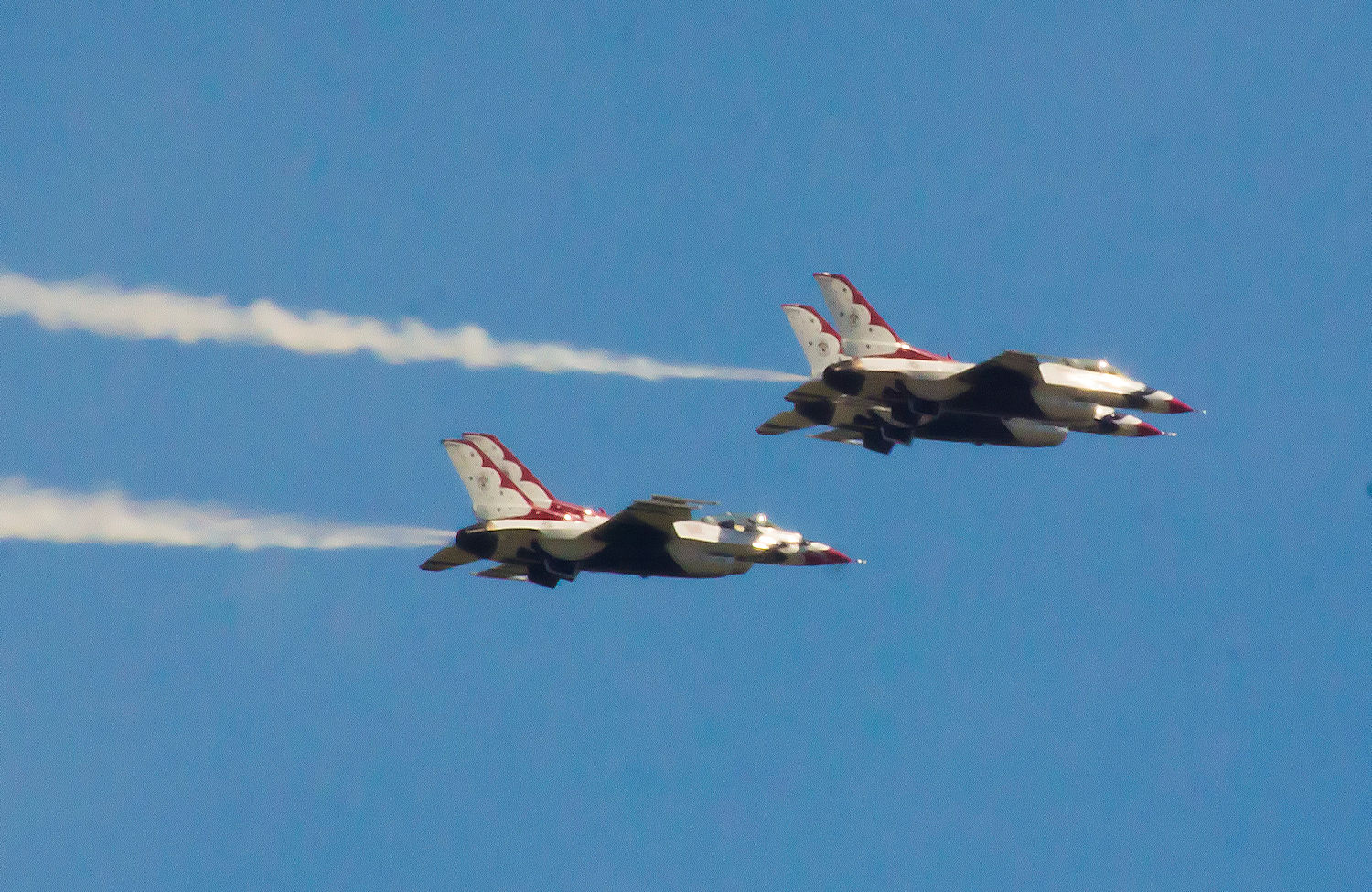
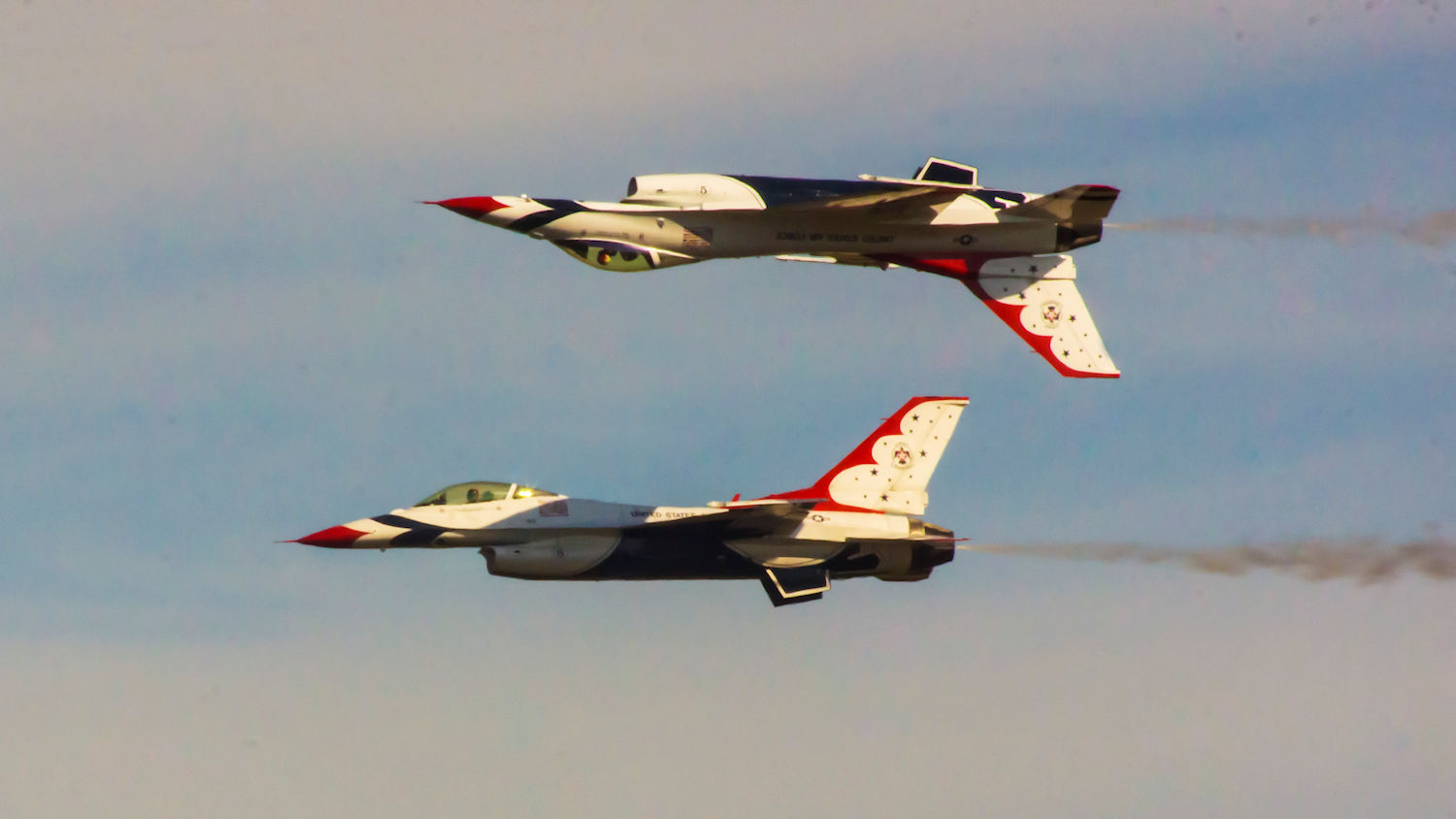
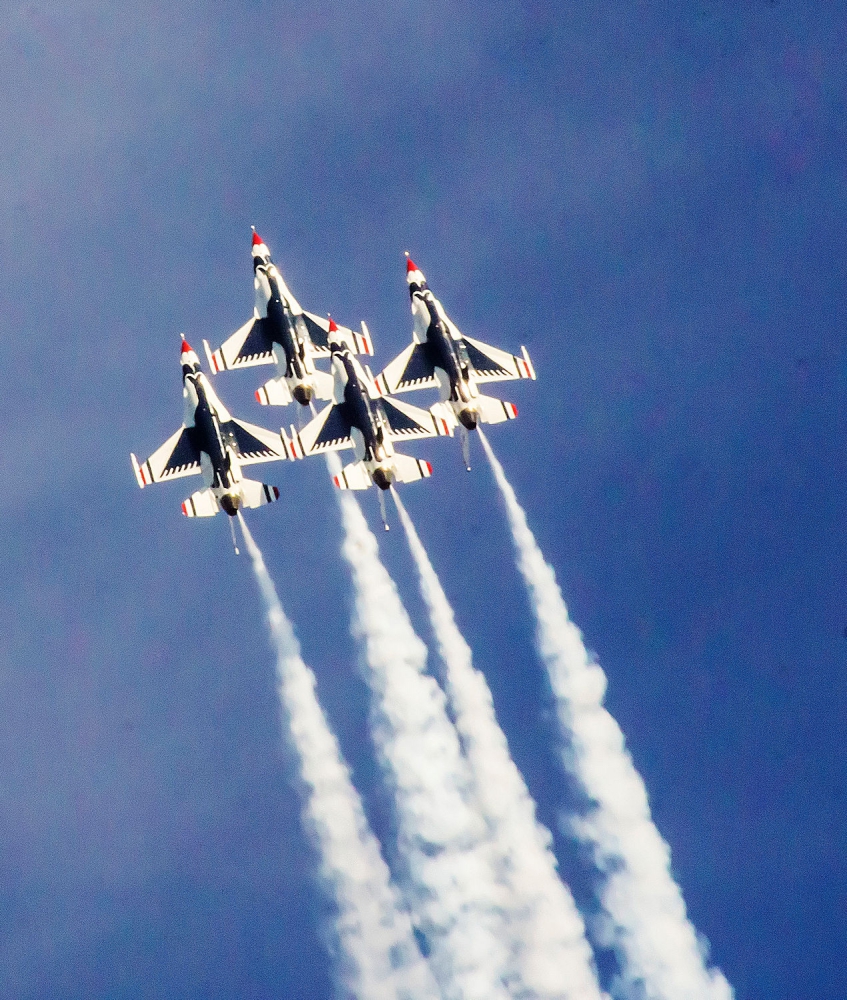
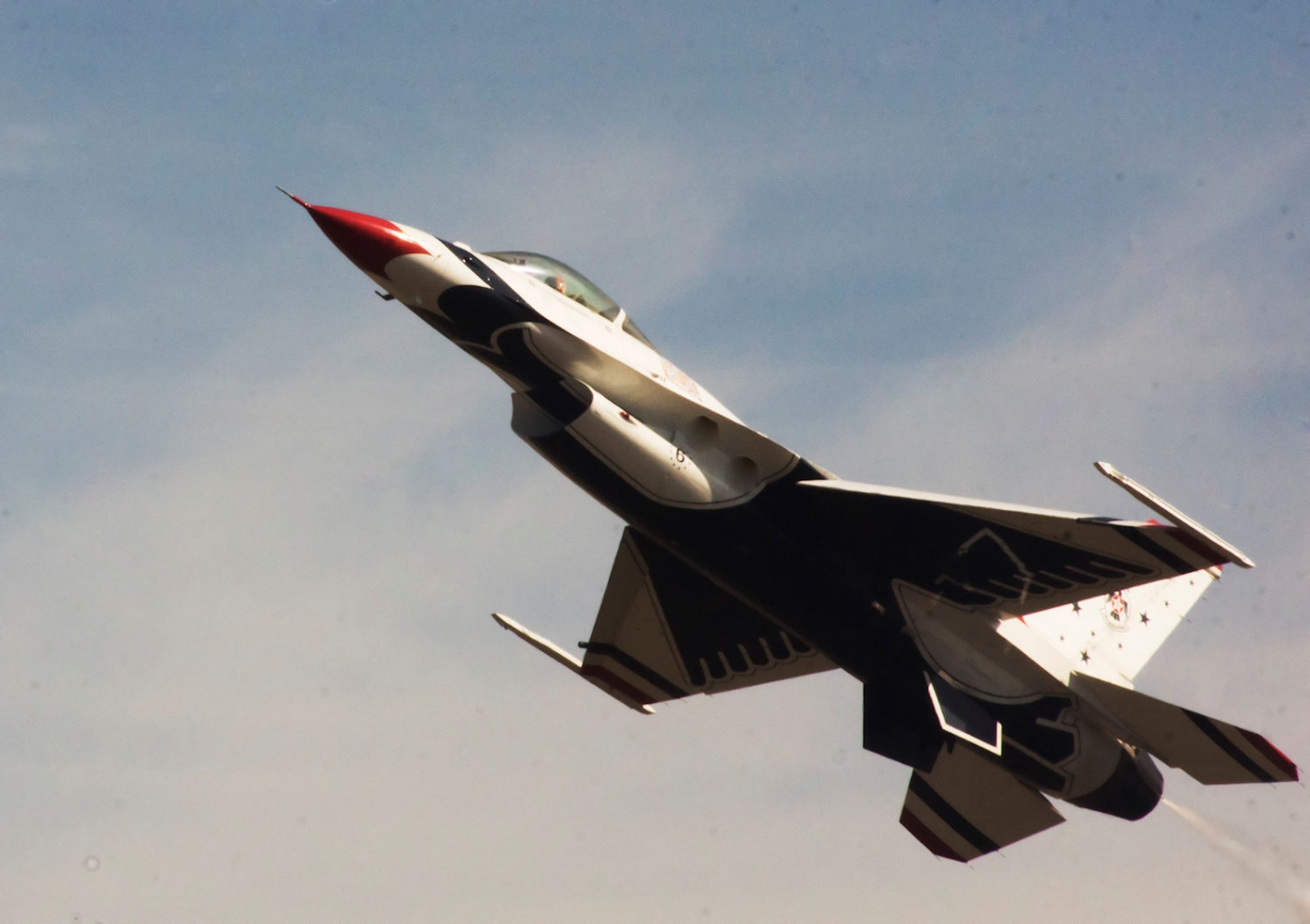
Another precision aerobatics team was at the show: the France-based Breitling team, flying Czech-built L-39 Albatrosses. This seven-plane team put on a good show.

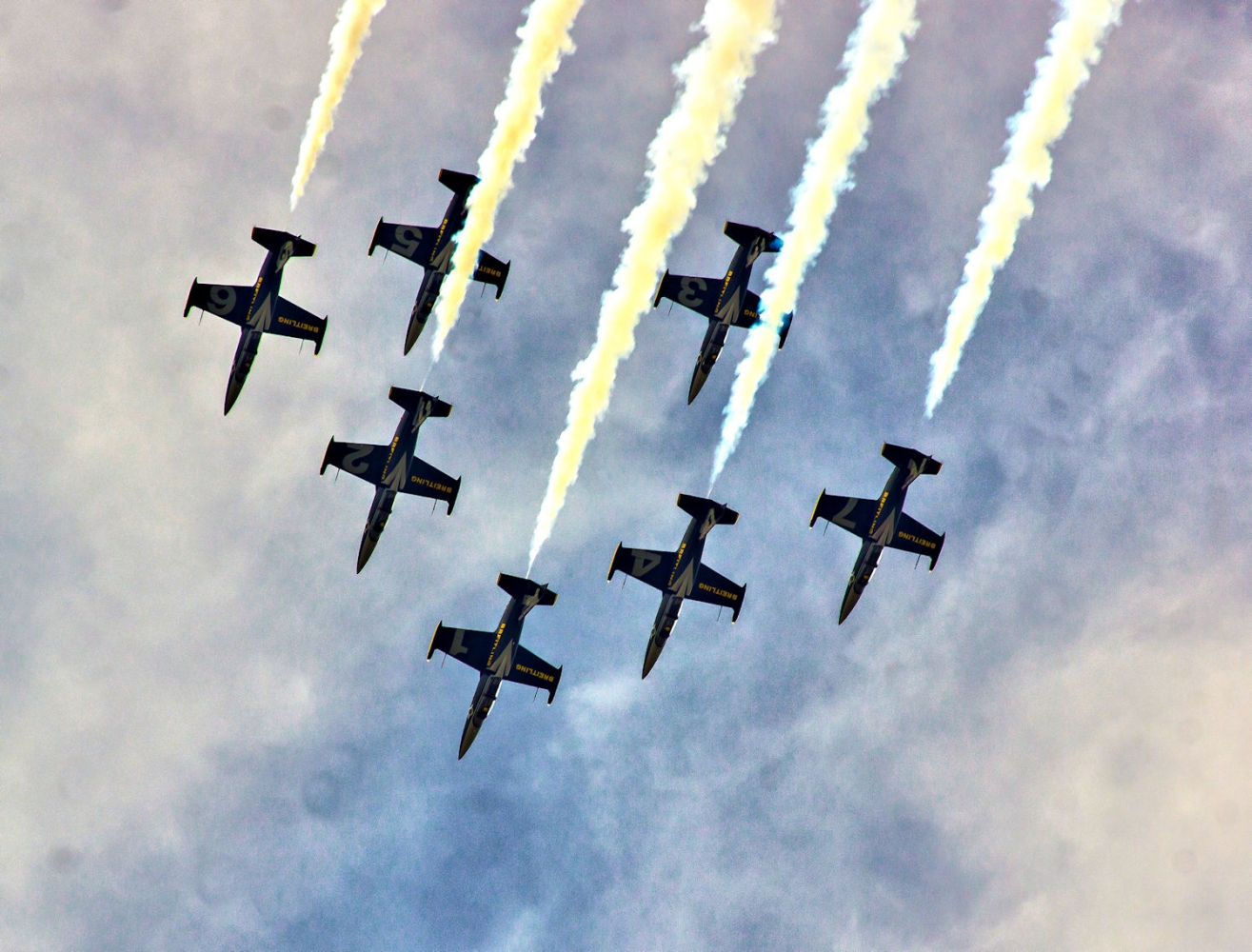
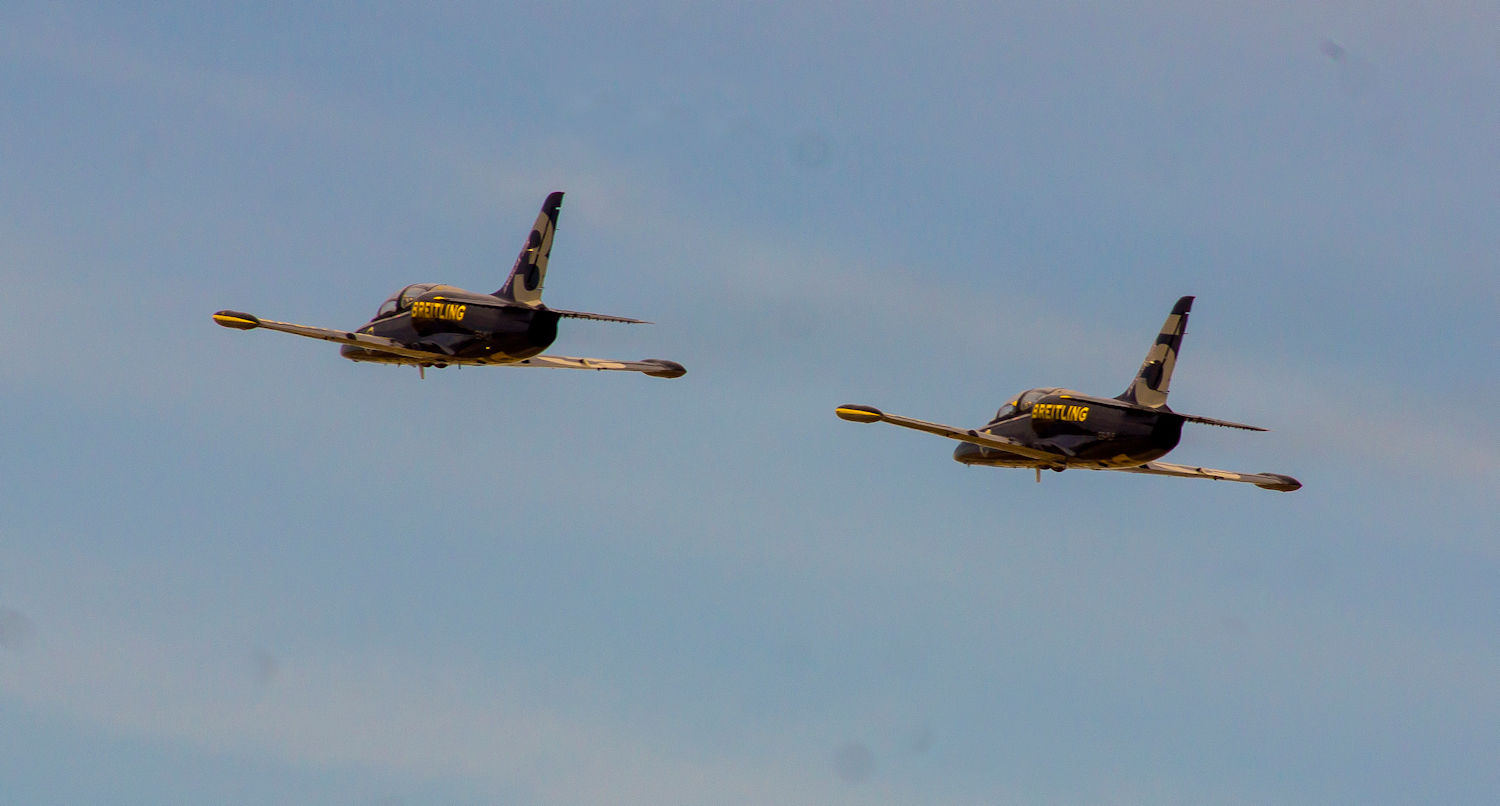
Filling the "current technology fighter" role for the show was an FA-18 Super Hornet. It looks very similar to the original FA-18, but they're actually two entirely different aircraft. The Super Hornet is larger and faster than the plain old Hornet, plus it's a two-seater, whereas the Hornet seats one. The pilot put his plane through a variety of maneuvers, culminating in an on-the-deck supersonic flyby not more than a couple hundred meters away from the crowd -- if that. That's the first time I was so close to a jet as it broke the sound barrier. At first, you see the fighter but you don't hear a thing, then it zings by at over 700 mph, followed closely by two BOOMs!, the second louder than the first, and then the deafening roar of its exhaust in full afterburner comes crashing down show center.
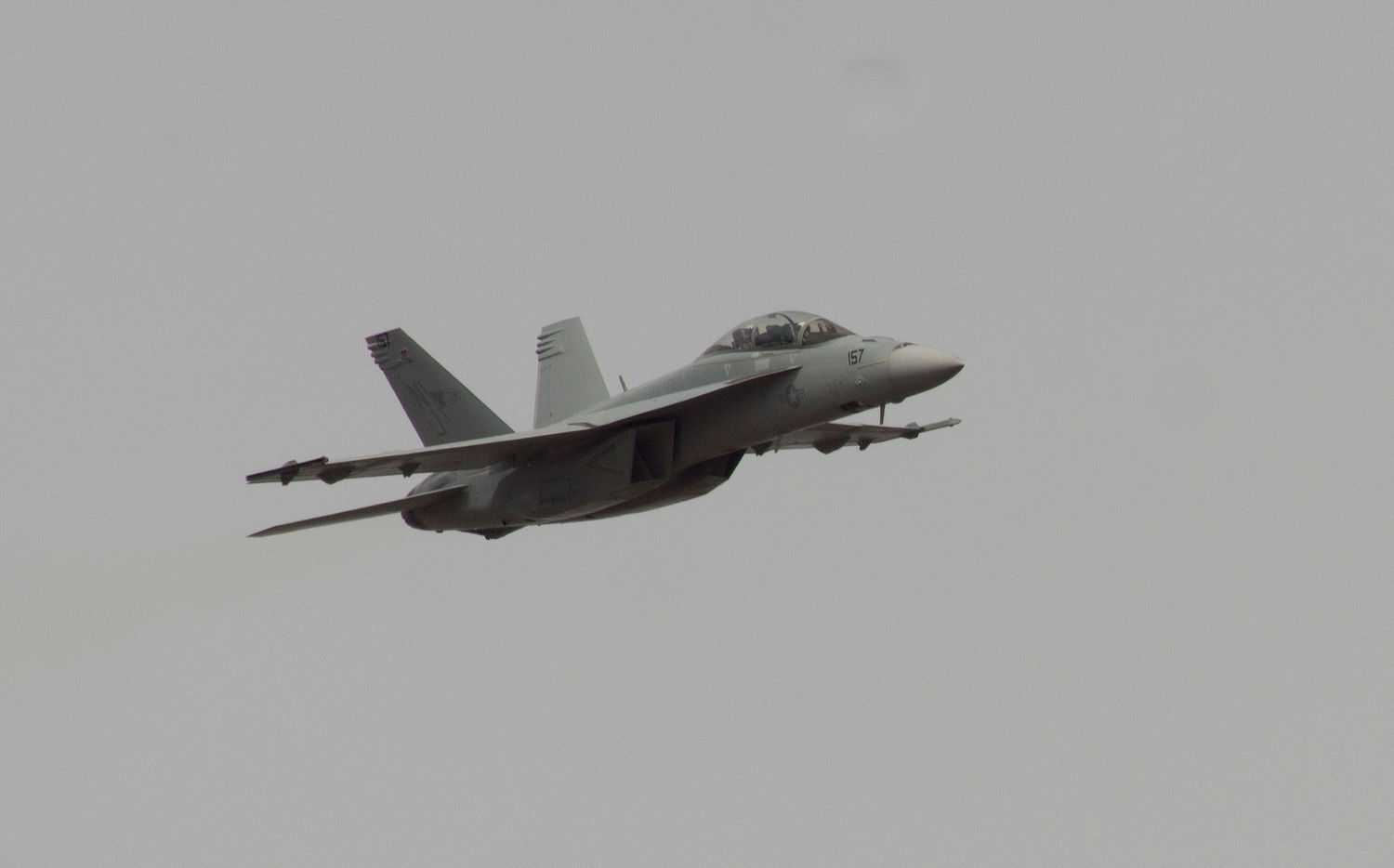
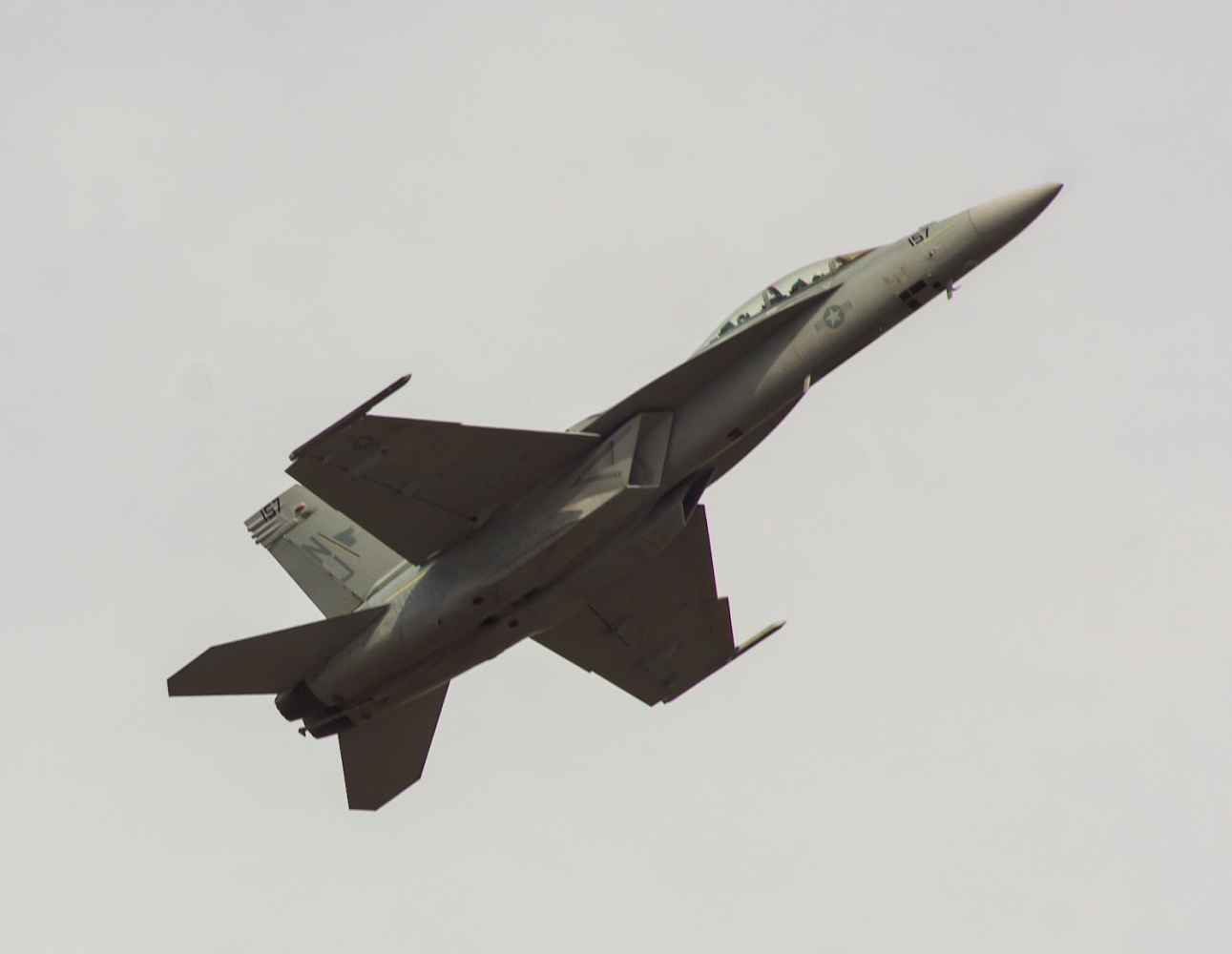
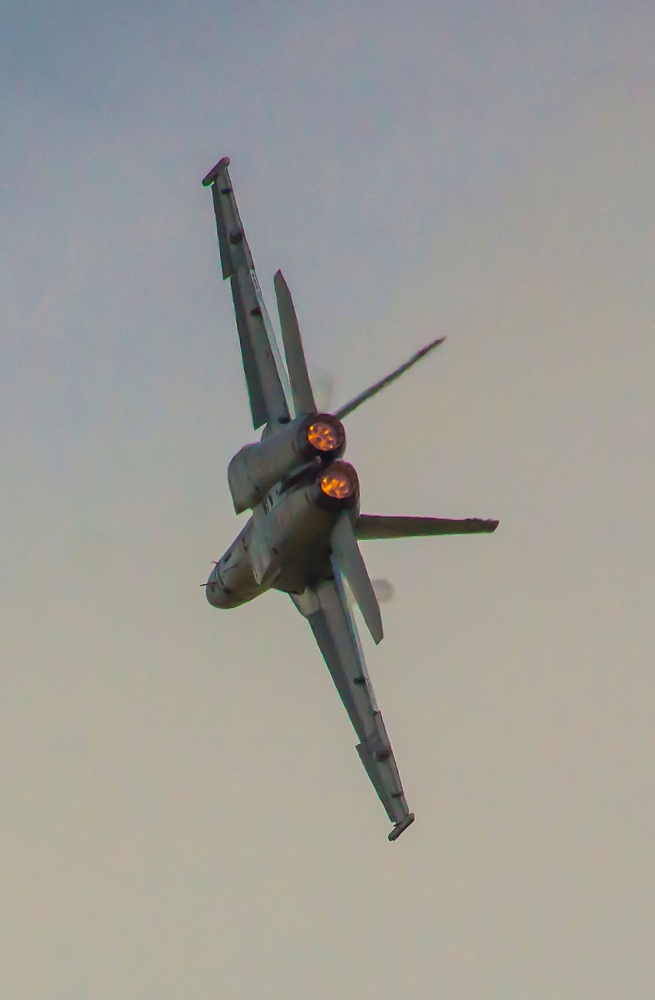
This year, there was a good turn-out of WWII era warbirds, most of which were originally flown by the US Navy and Marines, ironically enough (the location for the venue is an Air Force base and the USAF Thunderbirds were the main act, after all). One thing I've learned over the years, when shooting propeller-driven aircraft, the ideal shutter speed is 1/125 second. It gives a good blur to the propellers at that setting. I/250 still works, but the blur is quite a bit less. Still, I was hand-holding that 300mm f/2.8 lens, so I was trying to keep the shutter speed over 1/500 to reduce camera shake. But the problem with this is it stops the prop and the plane looks like it's just hanging there in the air. So I have quite a few shots of propeller driven aircraft with stopped props. At least there was no camera shake in those images. I was hoping that, by using the monopod, I could drop the shutter speed low enough to blur the props, and I did manage it with several shots, but because I wasn't able to use the monopod in all examples, I have more frozen prop photos than I care for.
There was a small contingent of dive and torpedo bombers that made the show, a Douglass Dauntless SBD dive bomber, a Curtiss SB2c dive bomber, and a Grumman TBF torpedo bomber.
I got quite a few nice pics of the Douglass SBD:
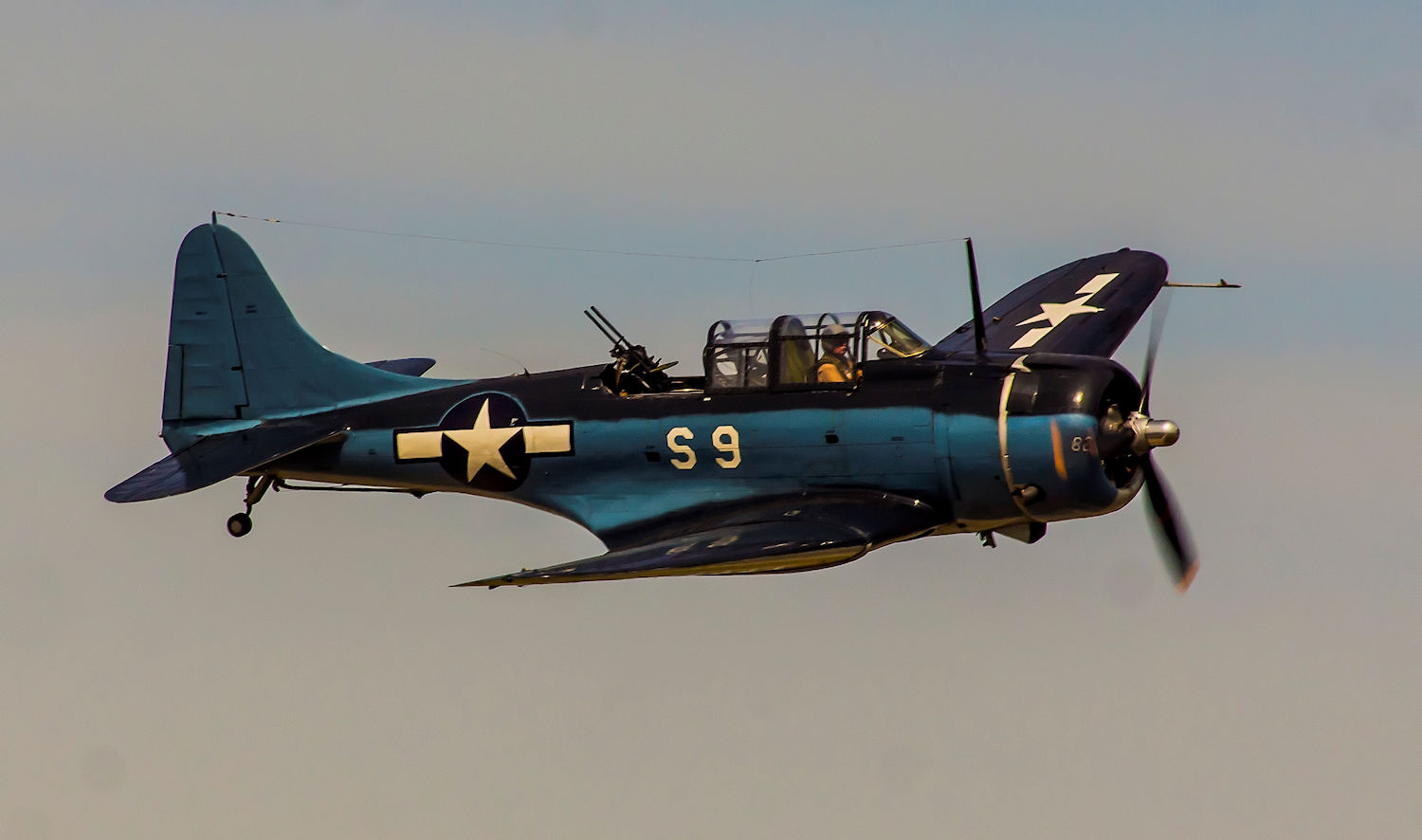
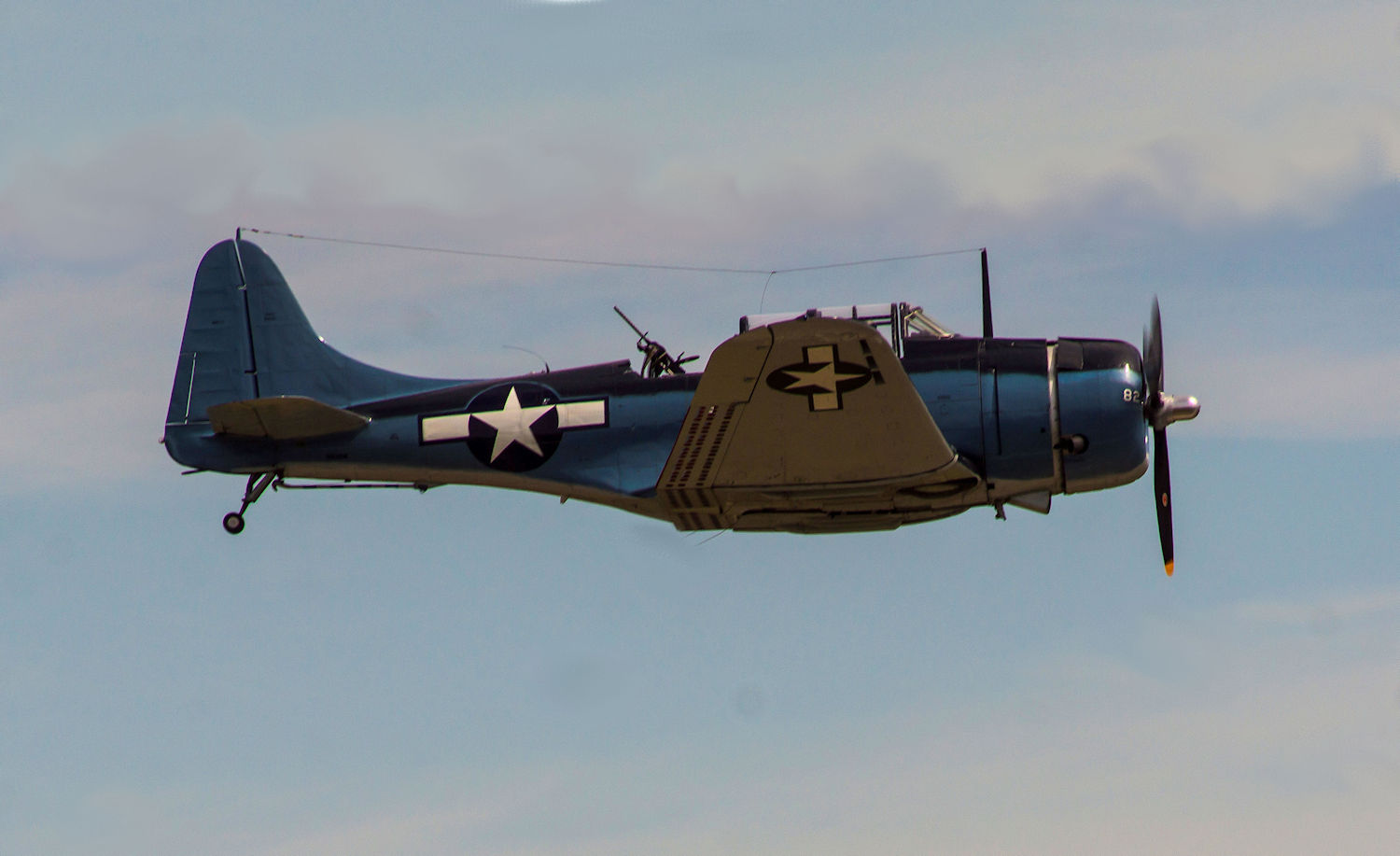

I also got some nice shots of the Grumman TBF:

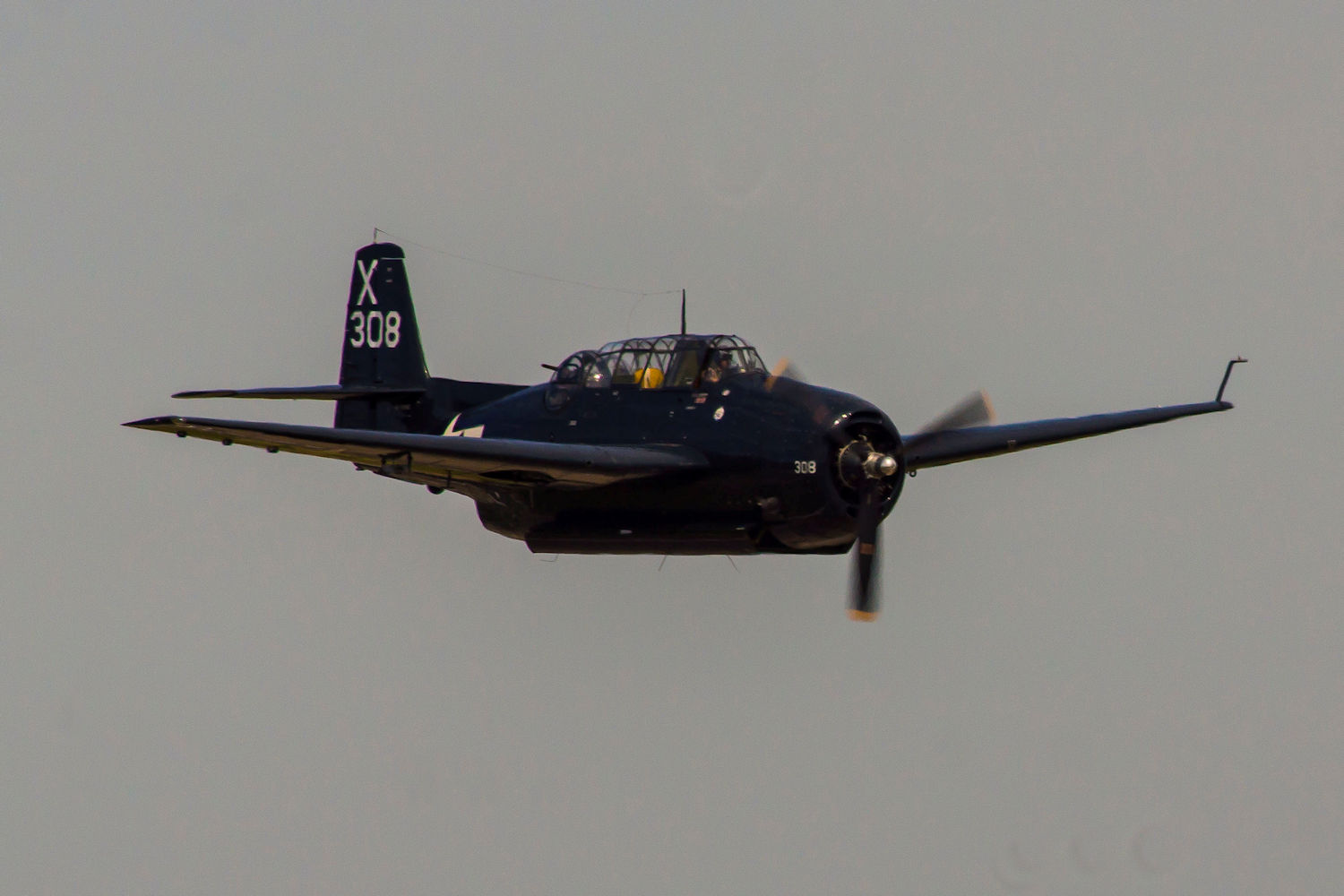
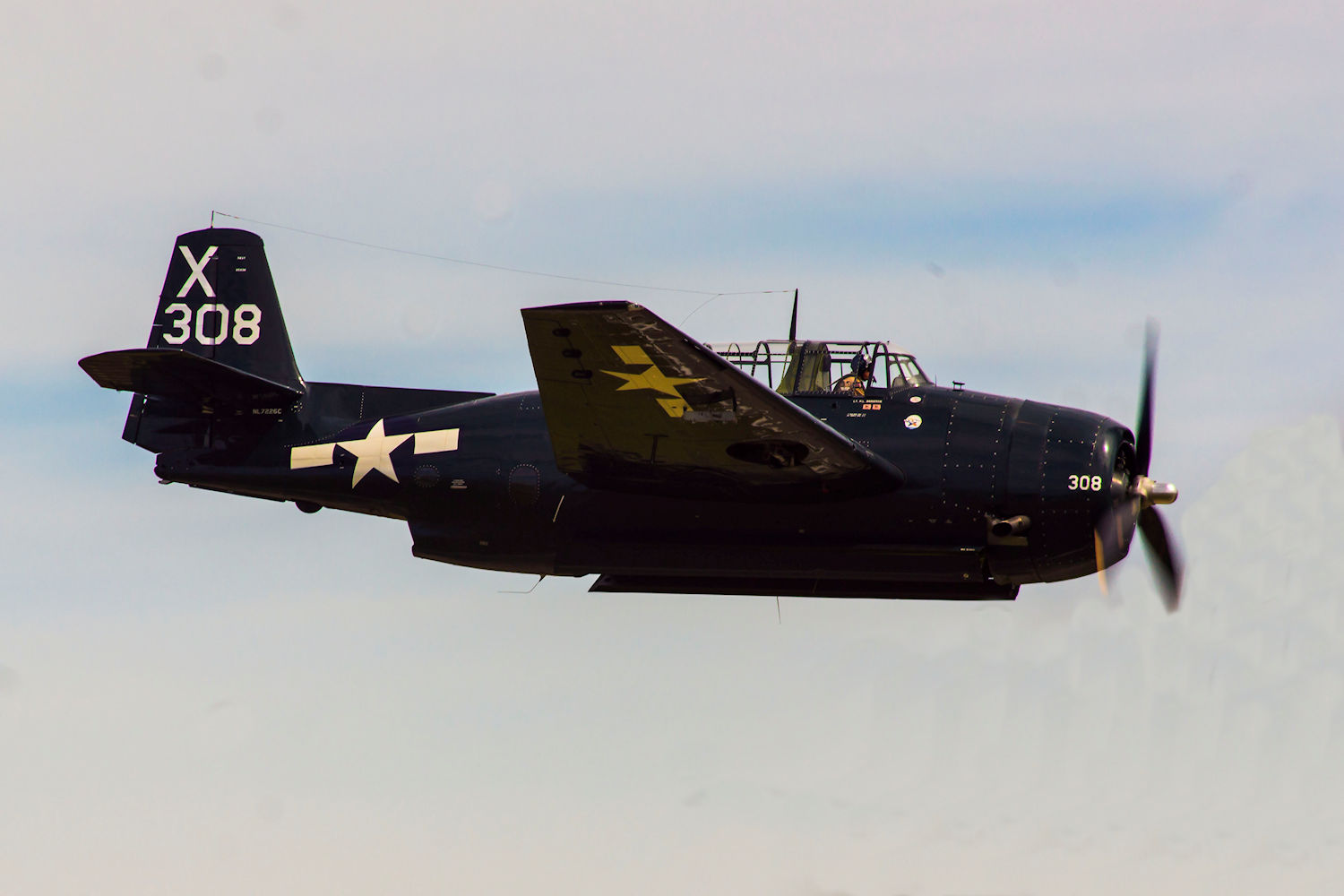
The Curtiss SB2c that was at the airshow is the last one flying in the world. I have pics of two SB2c's' from about six years ago, including this one, so I guess something happened to the other one.
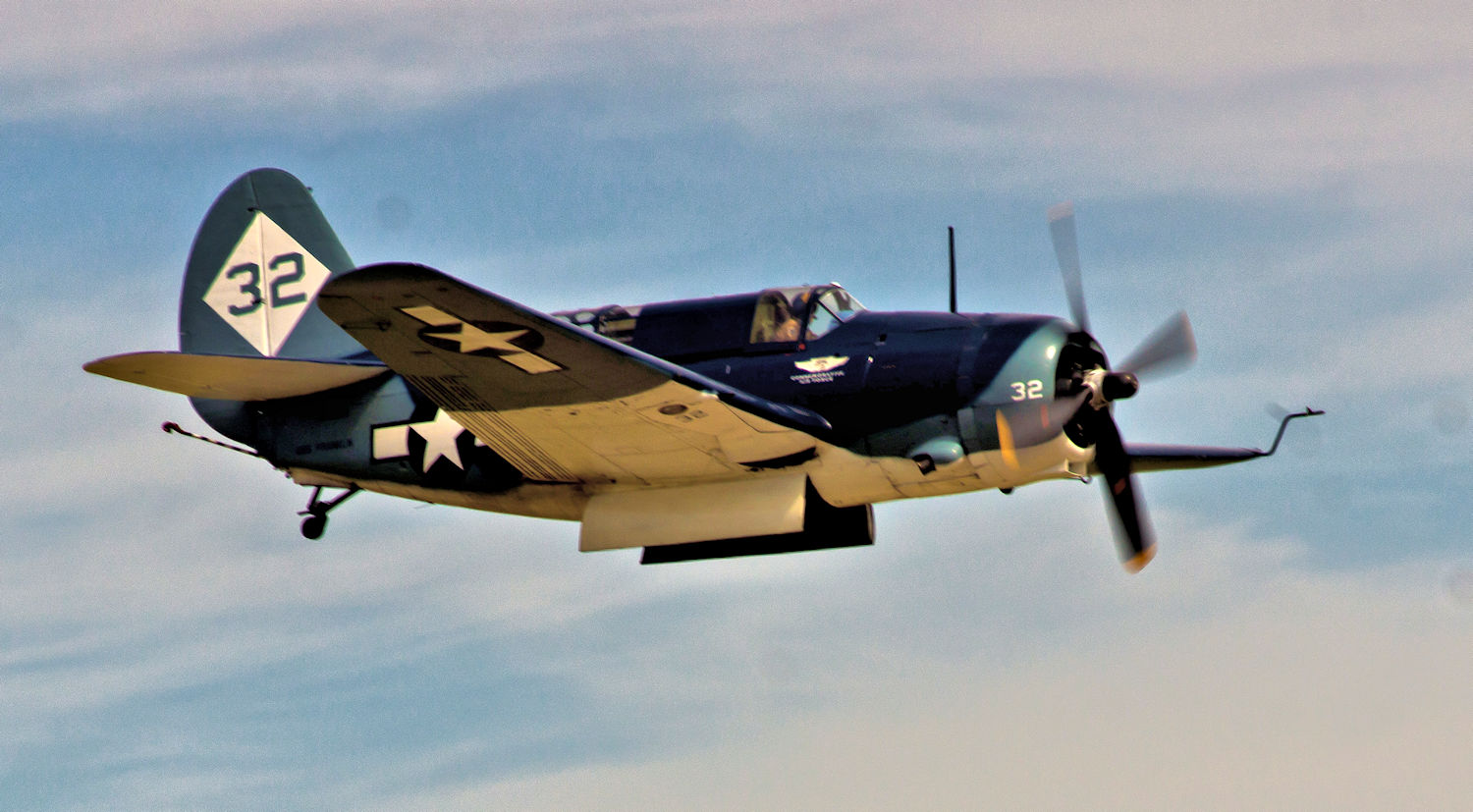
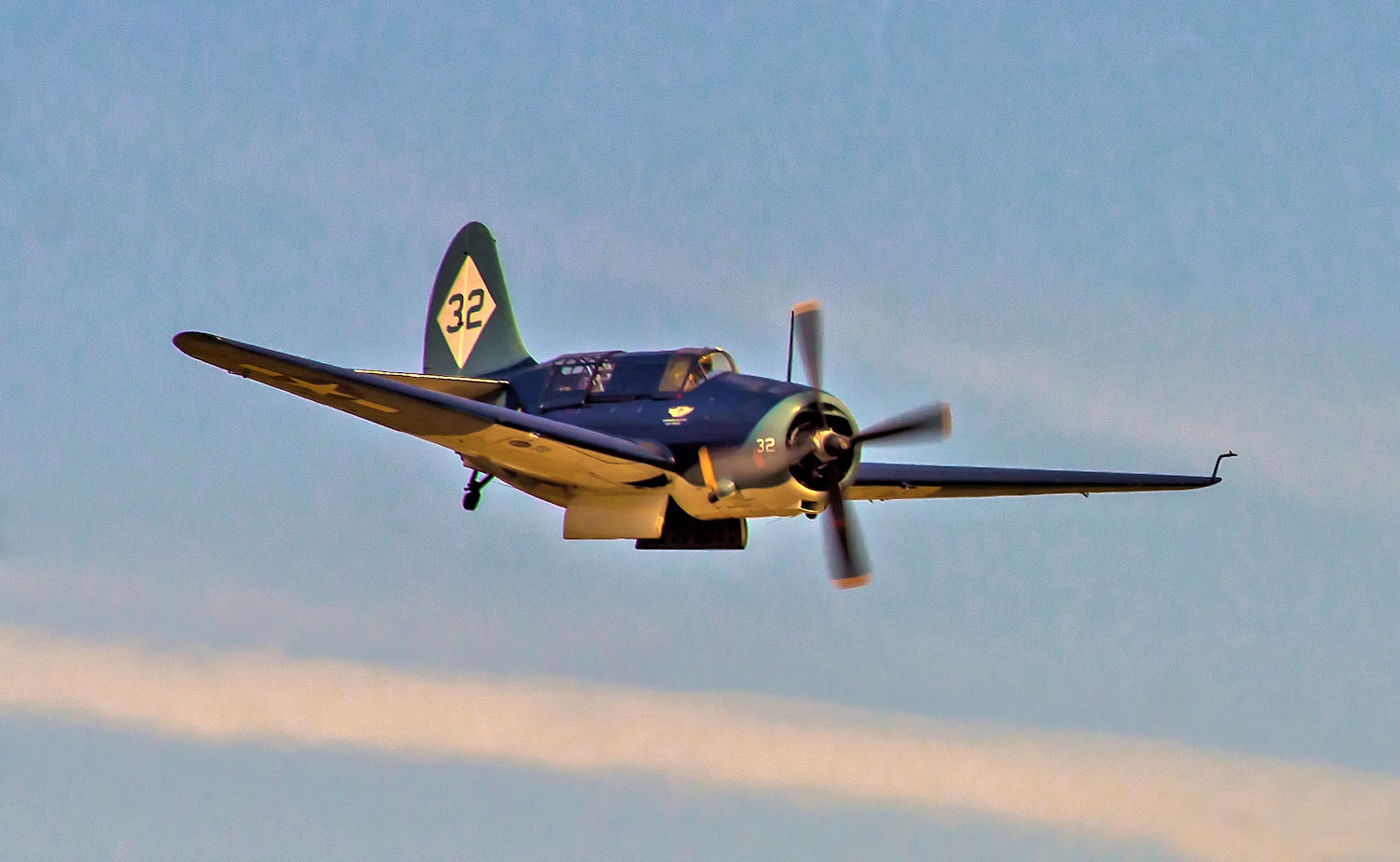
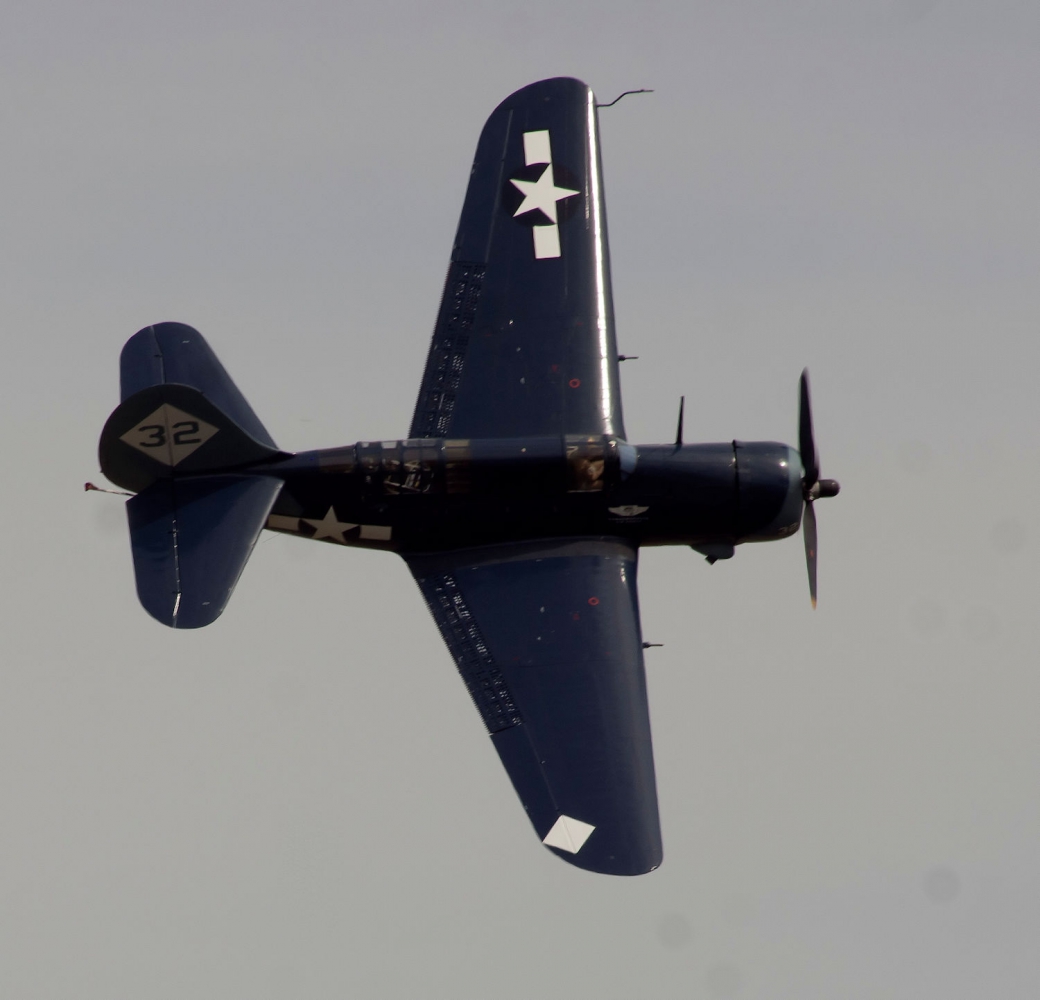
Another very rare aircraft, and one of only two left in the world in flying condition was this Messerschmitt ME-262, the bane of the Allied bomber crews during the closing months of WWII:
The first photo shows the 262 on takeoff, retracting its landing gear.
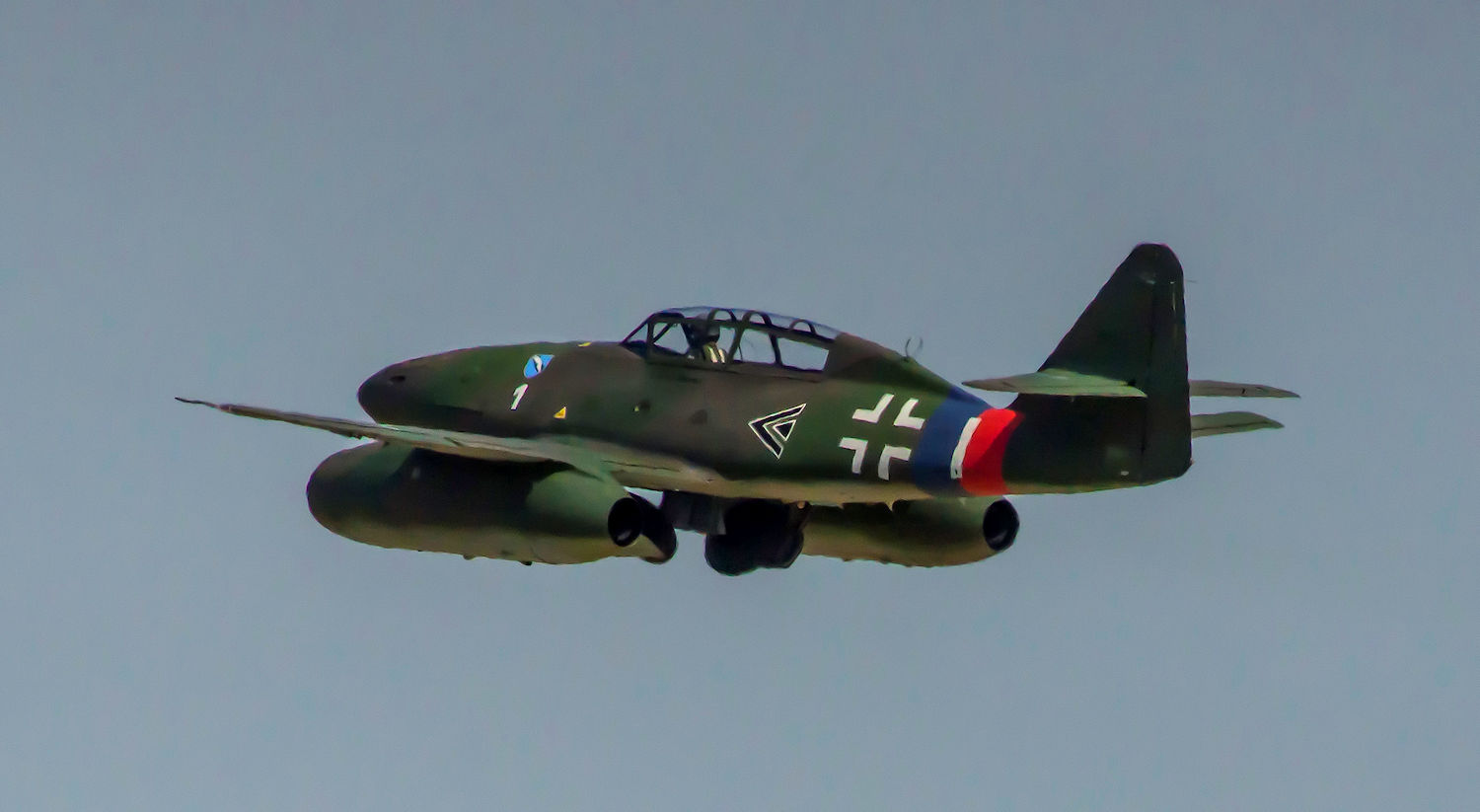
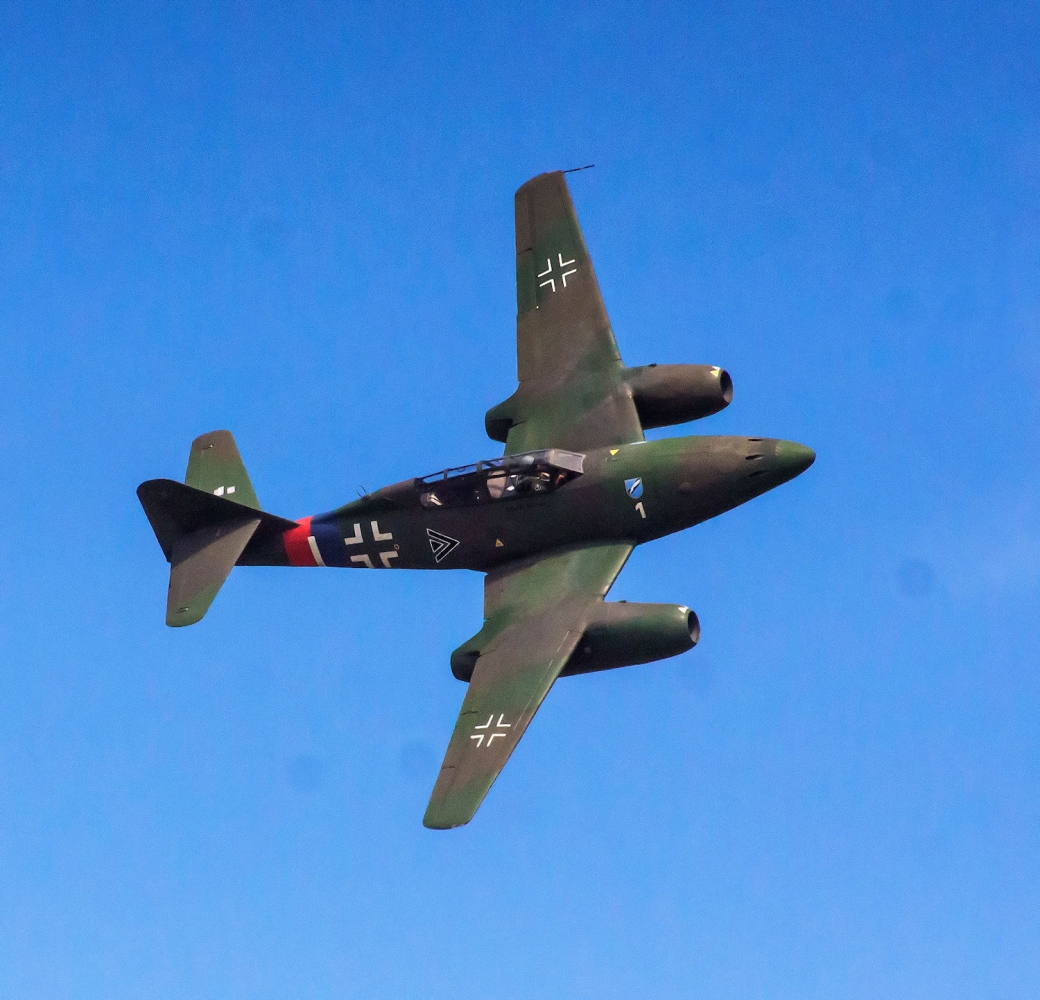
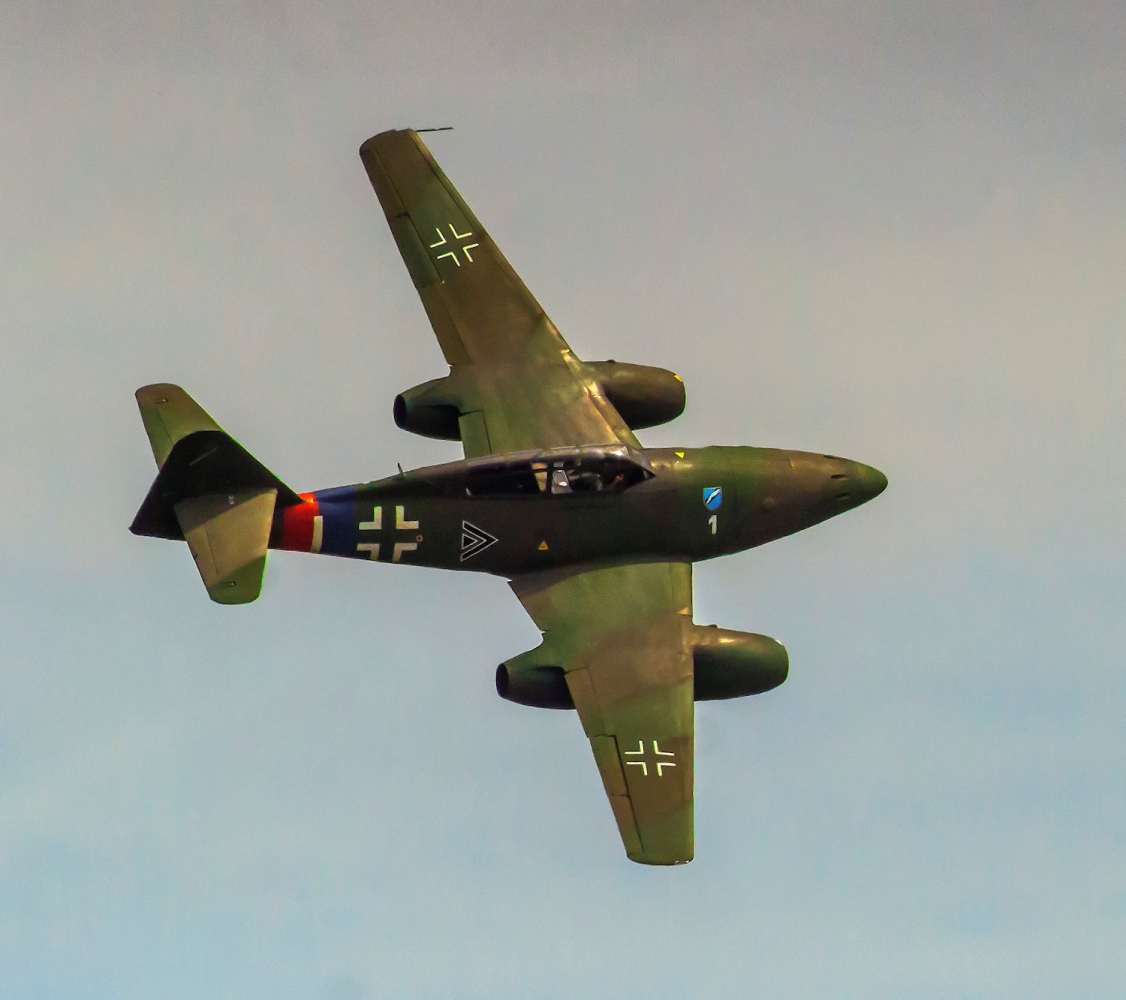
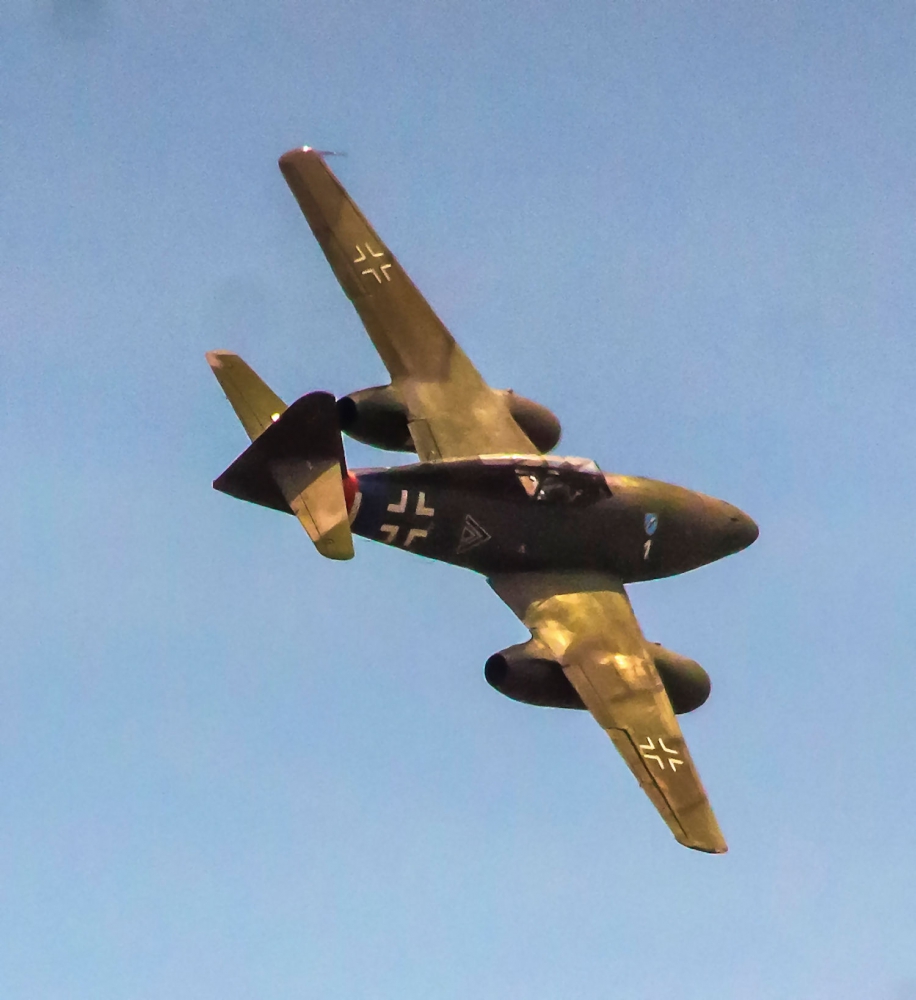
And yet another rare aircraft, one of only two left flying in the world, the Mitsubishi A6-M Zero. This one has the original Nakajima Sakae engine. The other one has a Pratt & Whitney engine fitted.
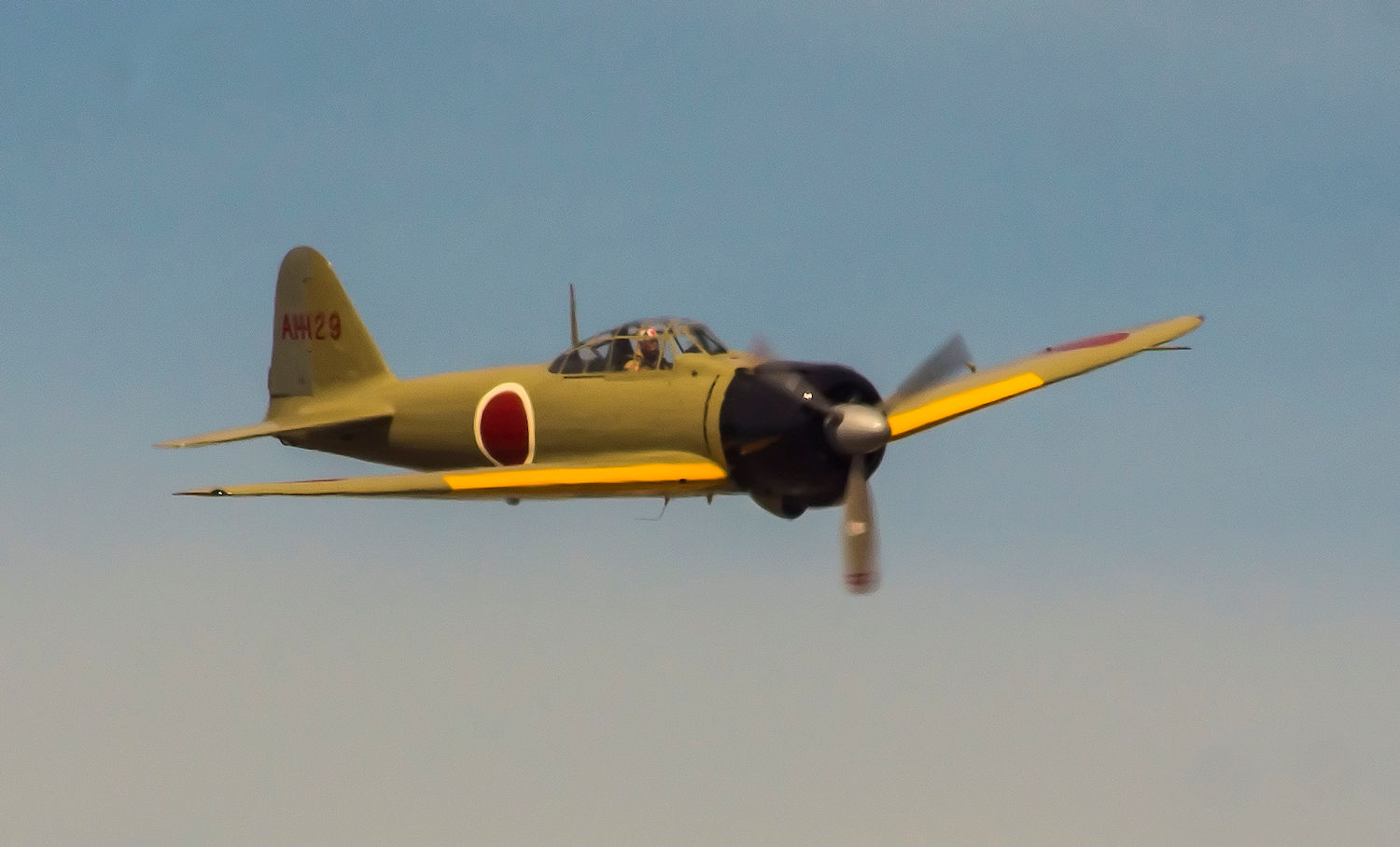
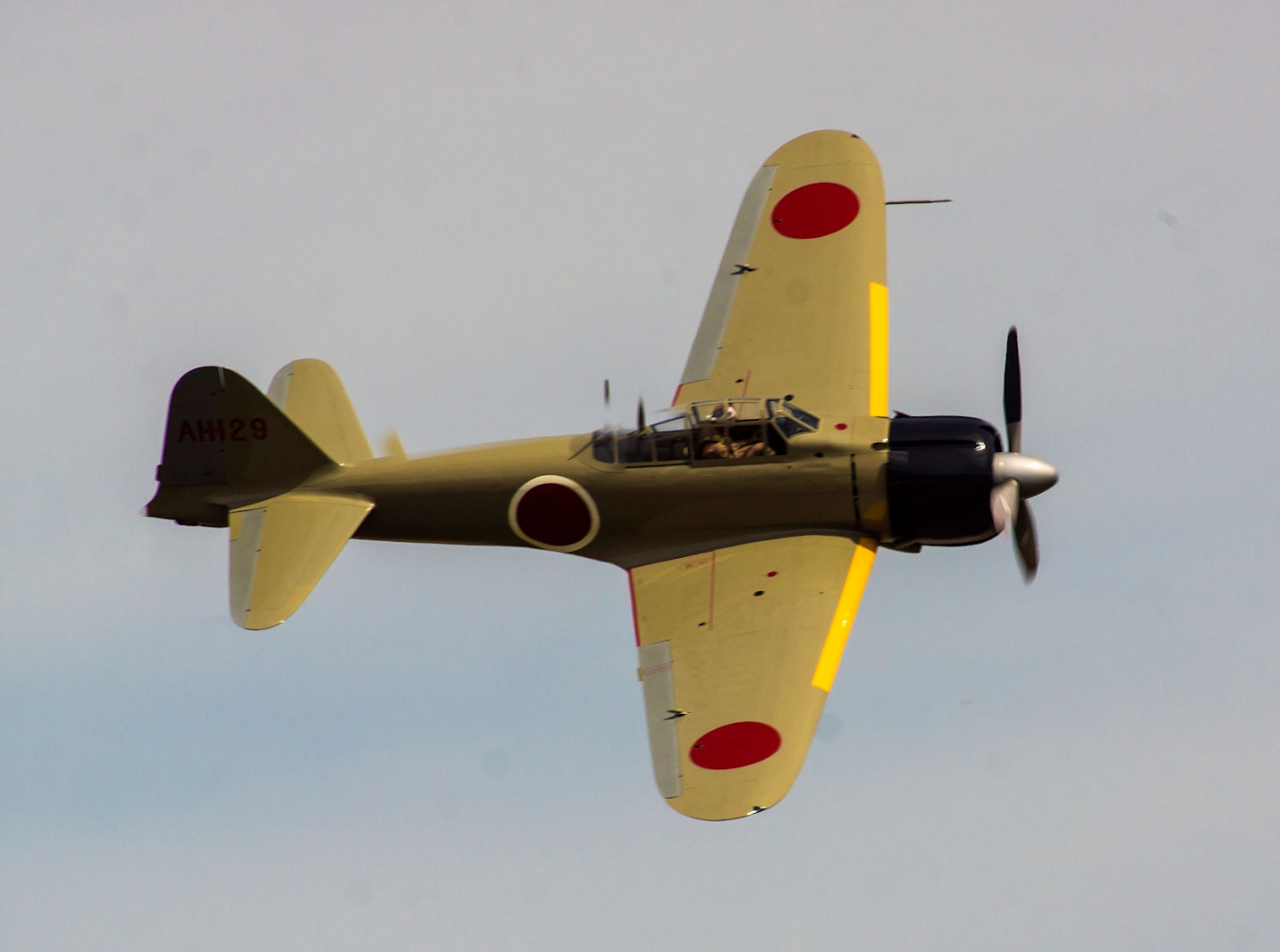
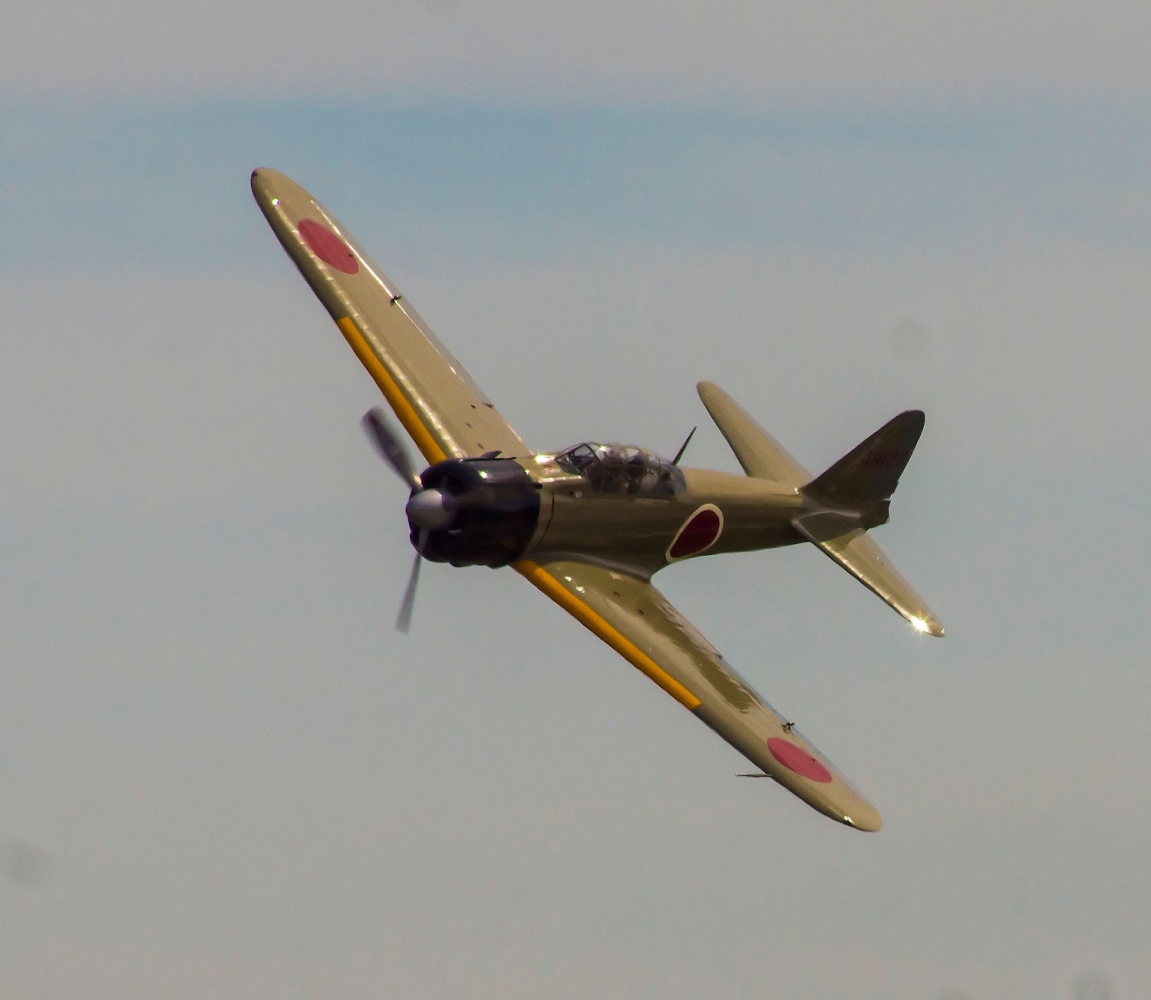
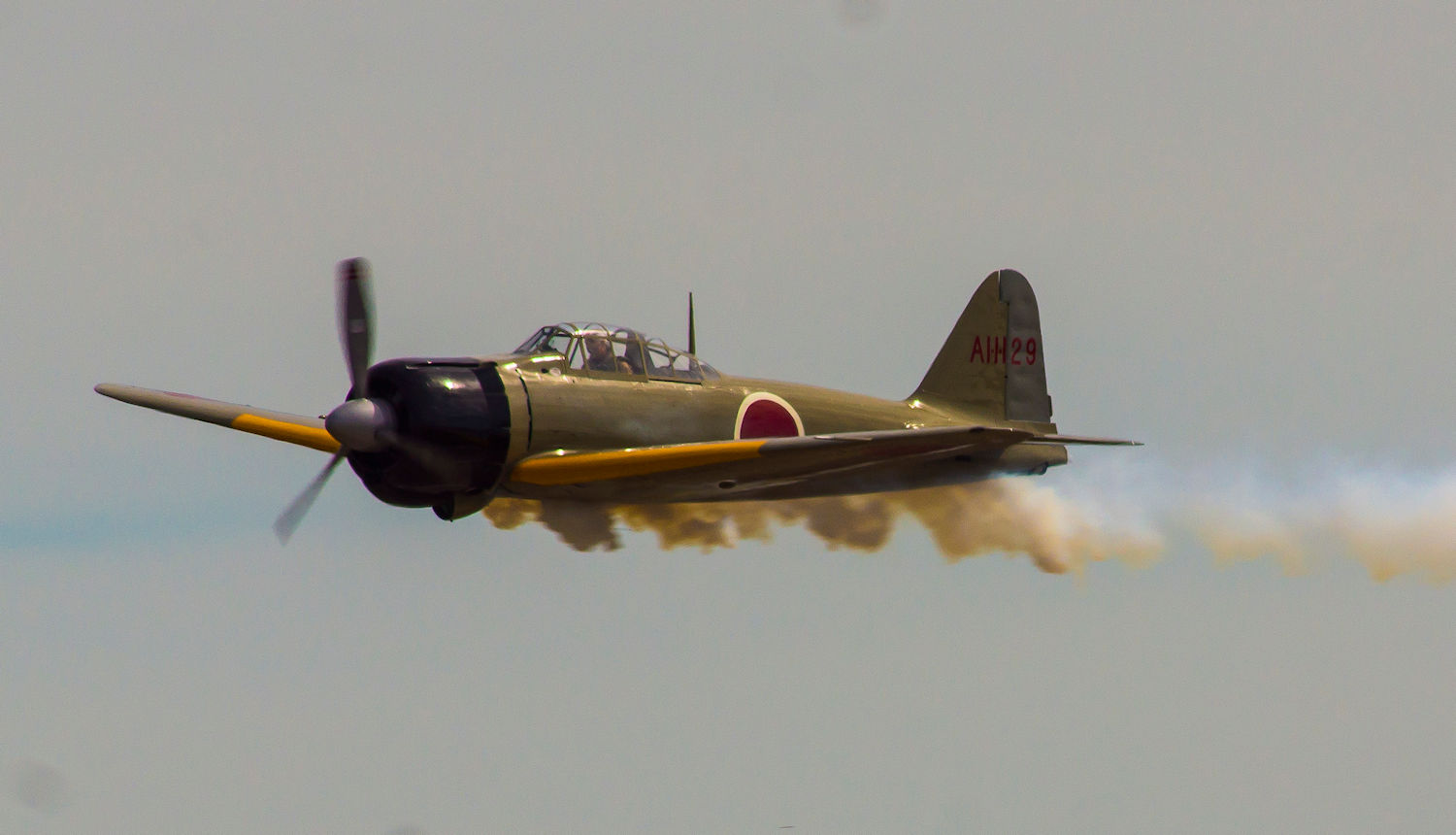
A nice Supermarine Spitfire made it to the show. I don't know which Mark this one is. Some folks can tell just by looking, but I'm not one of them. This is the nicest one I've seen in decades.
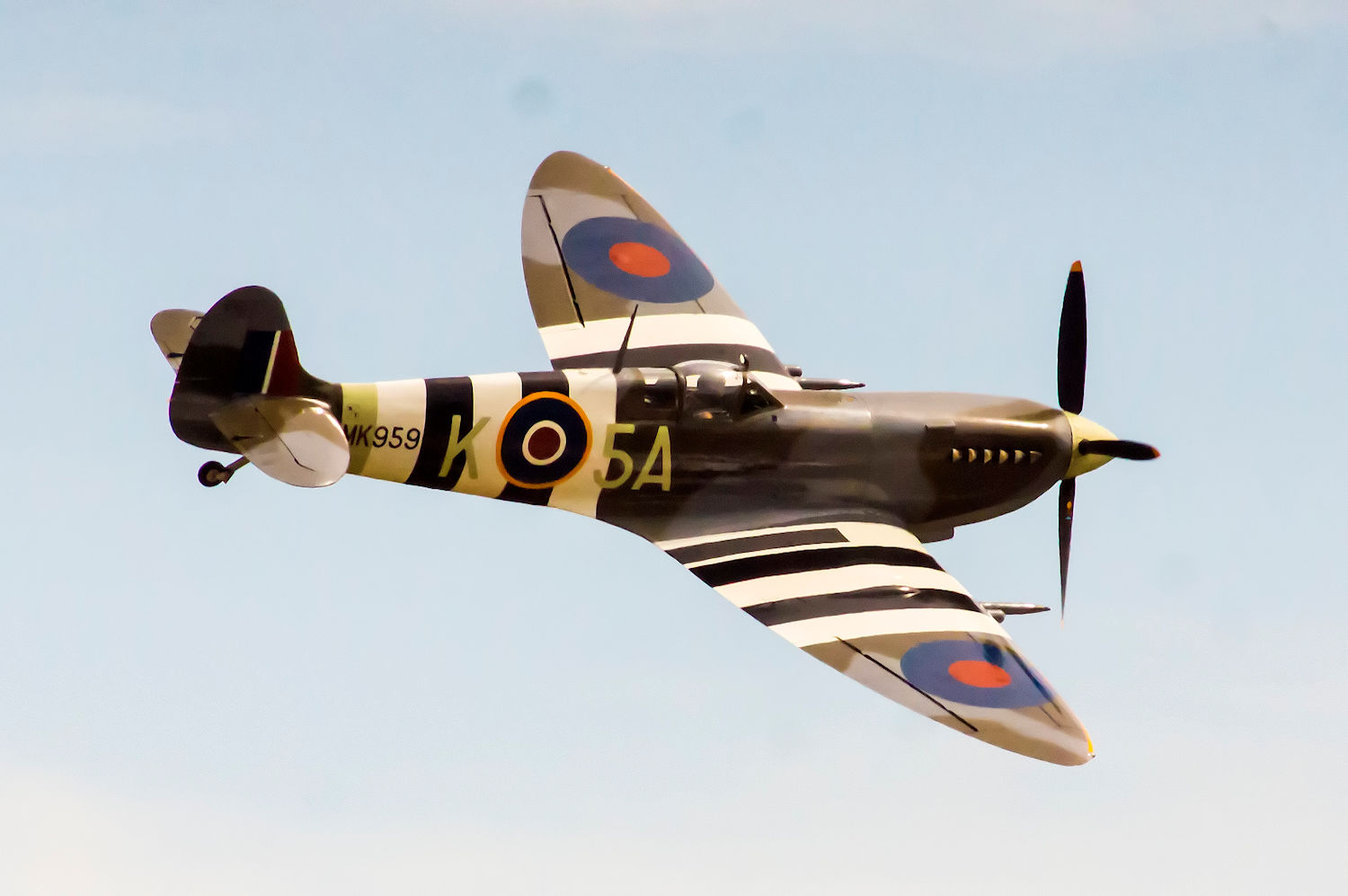
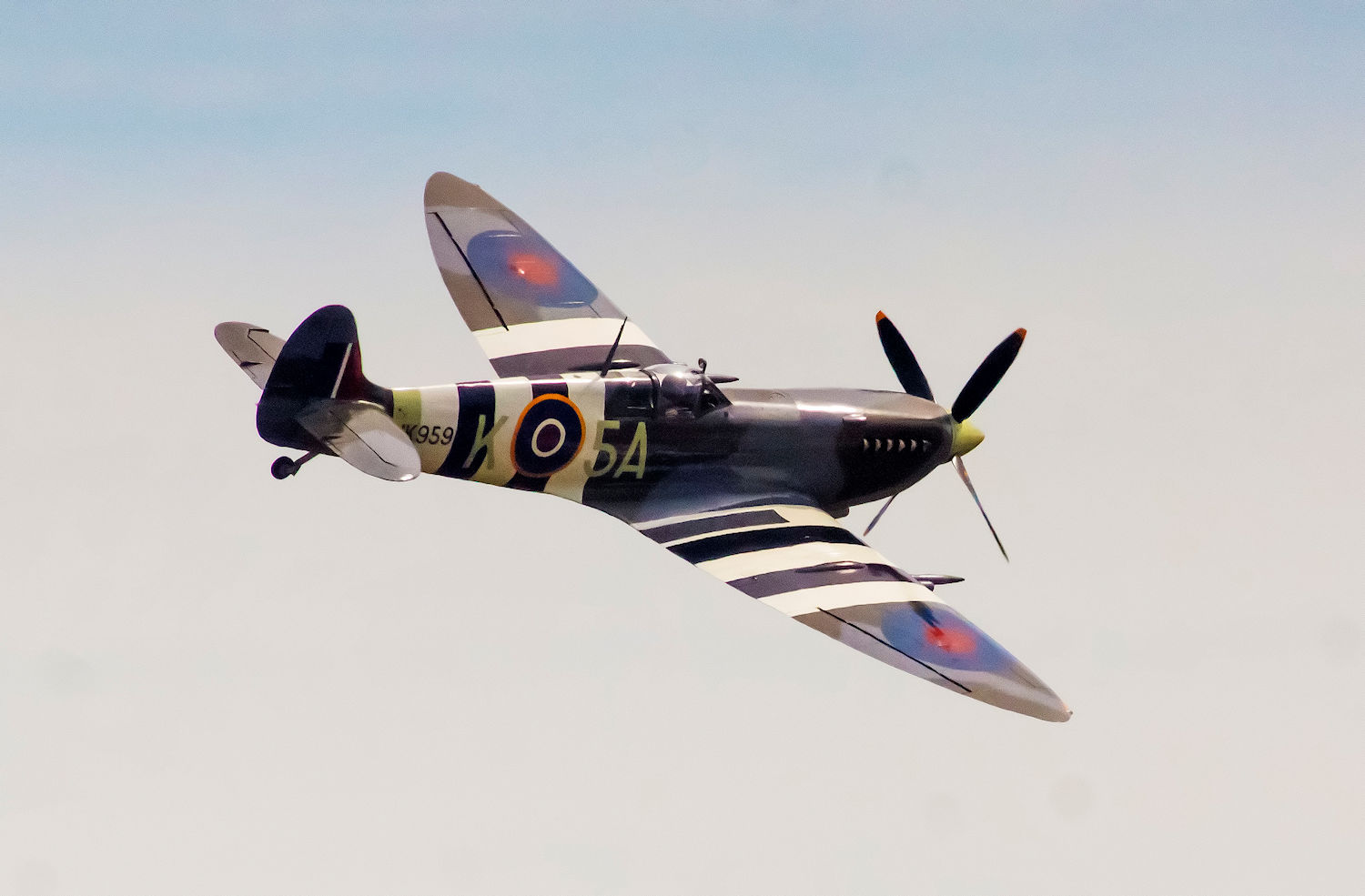

Something unusual, given its unerring popularity, there was only a single P-51 Mustang at the show. A beautiful example, though.

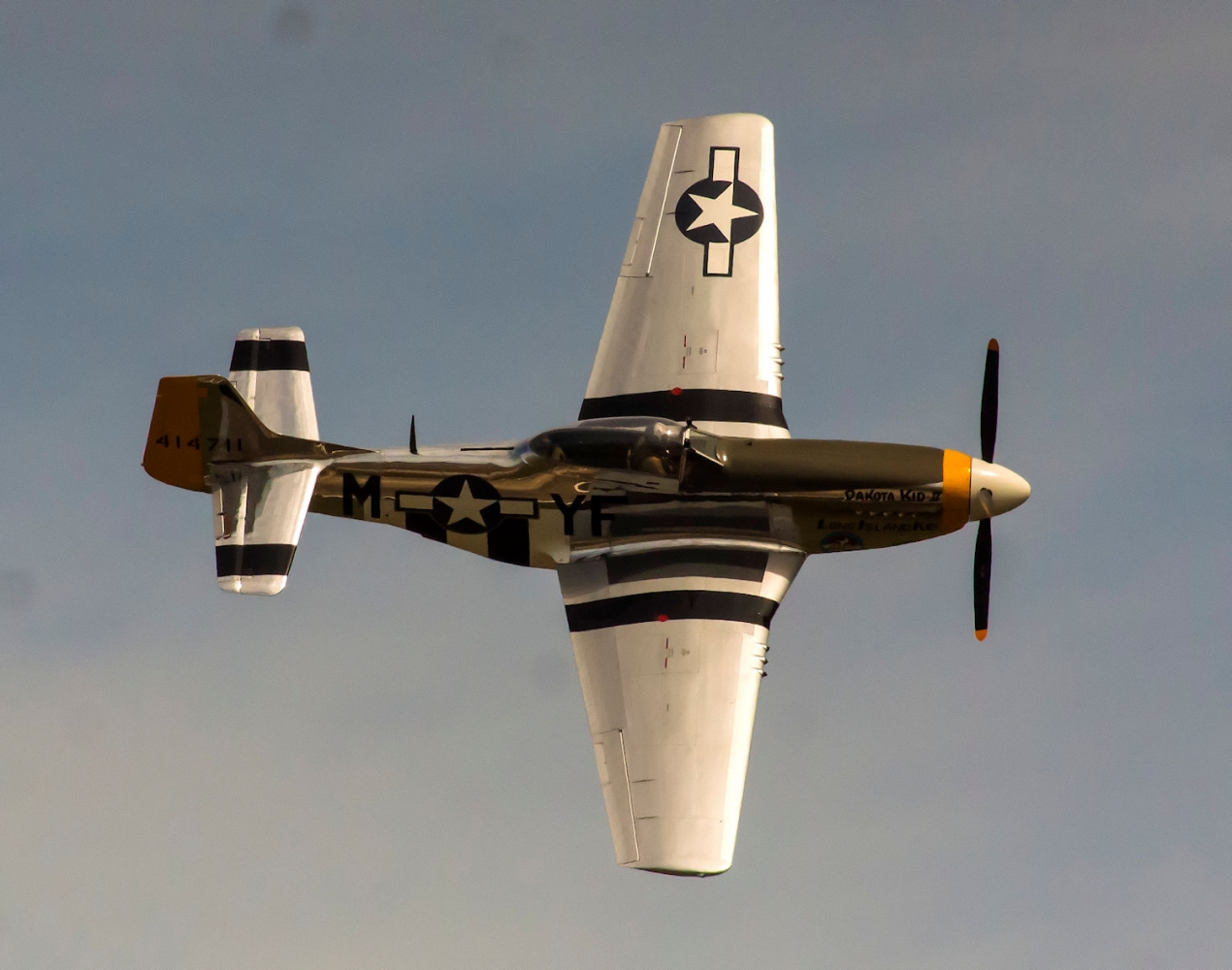
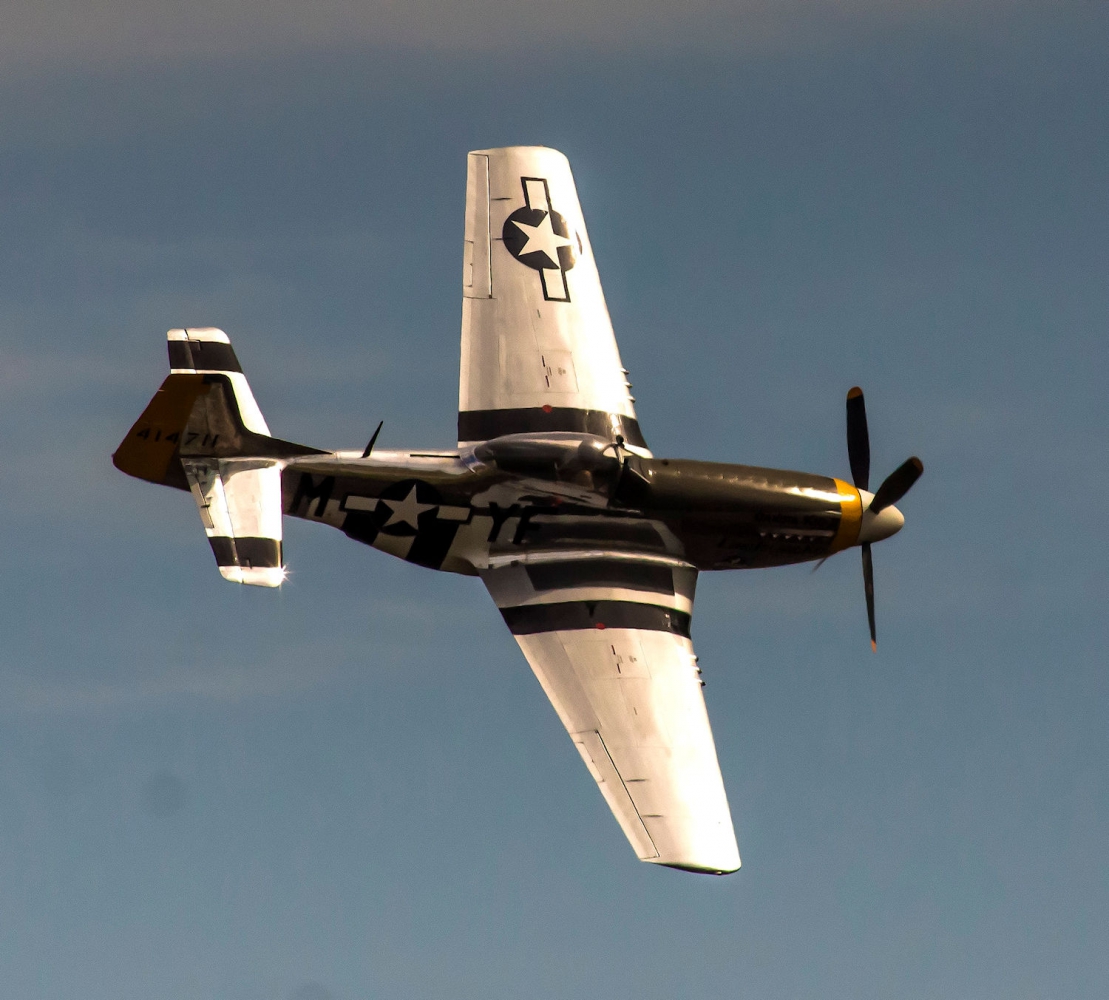
Sometimes the planes will get together and fly in formation. I've seen all types of formations at airshows, but I've neverr seen one quite like this one.
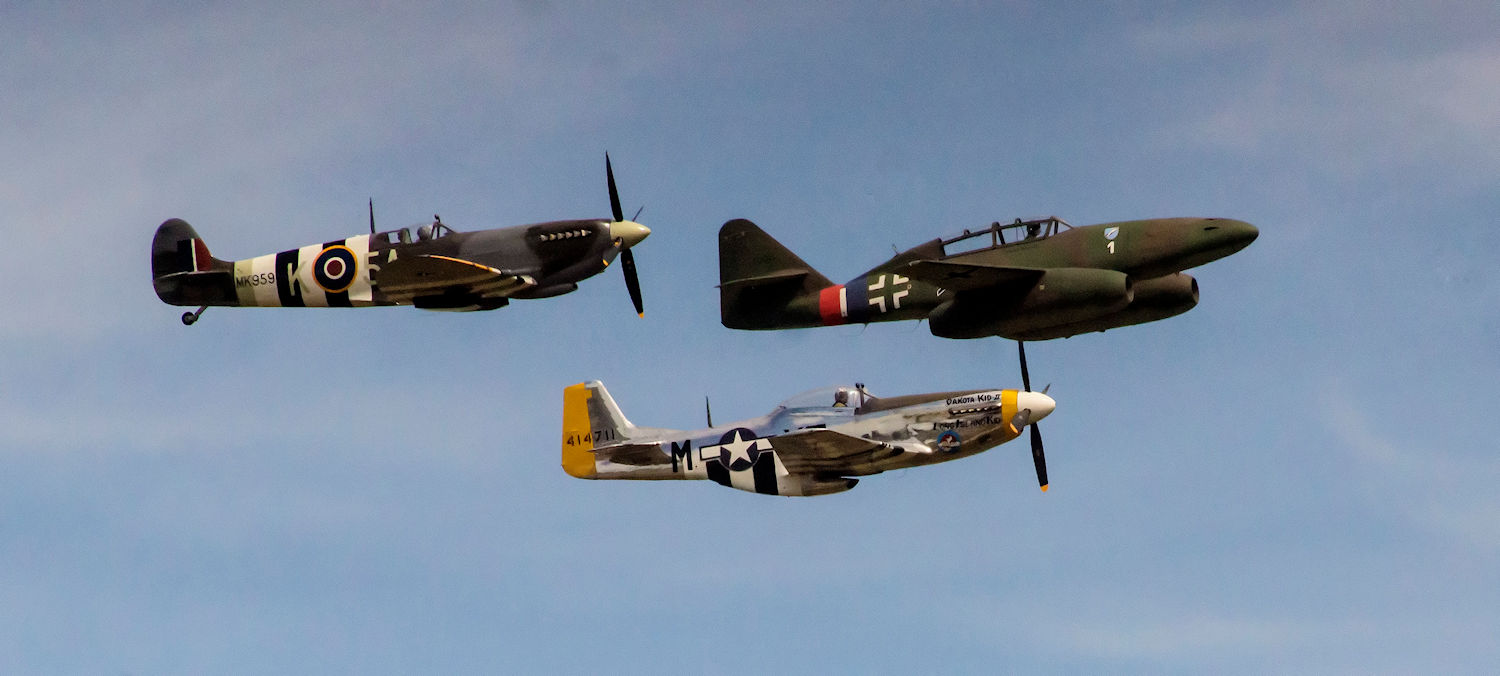
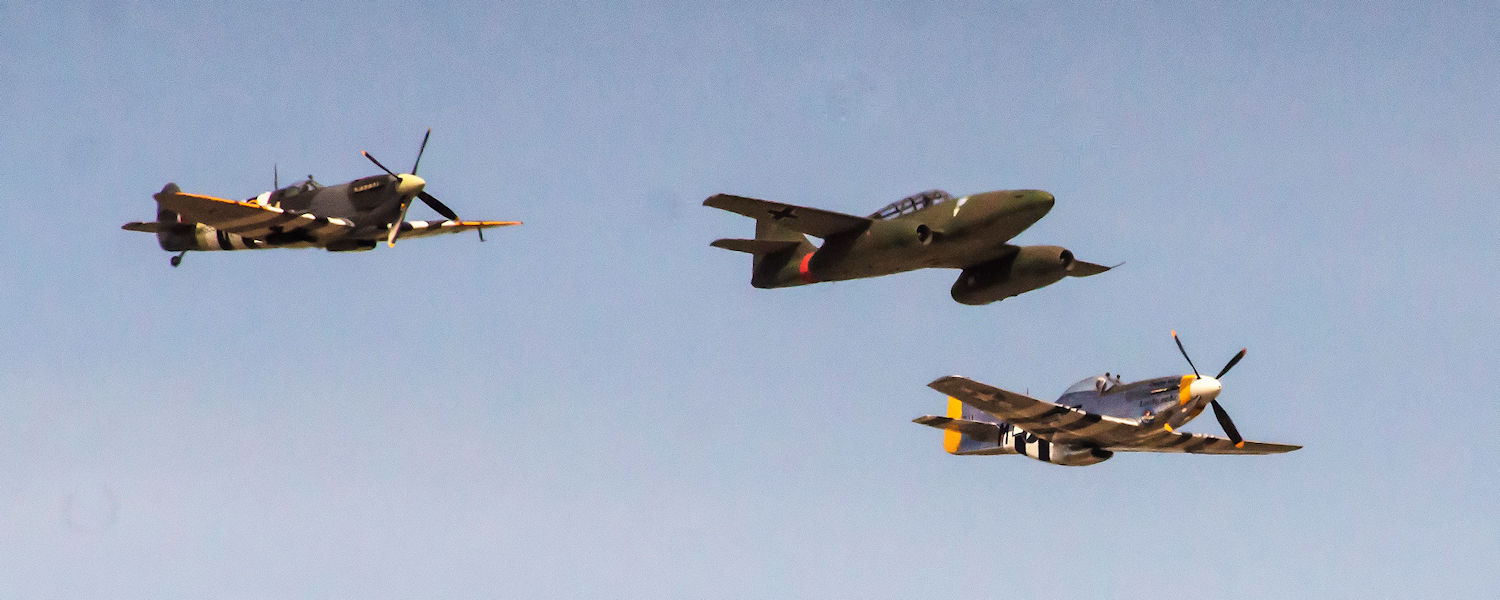
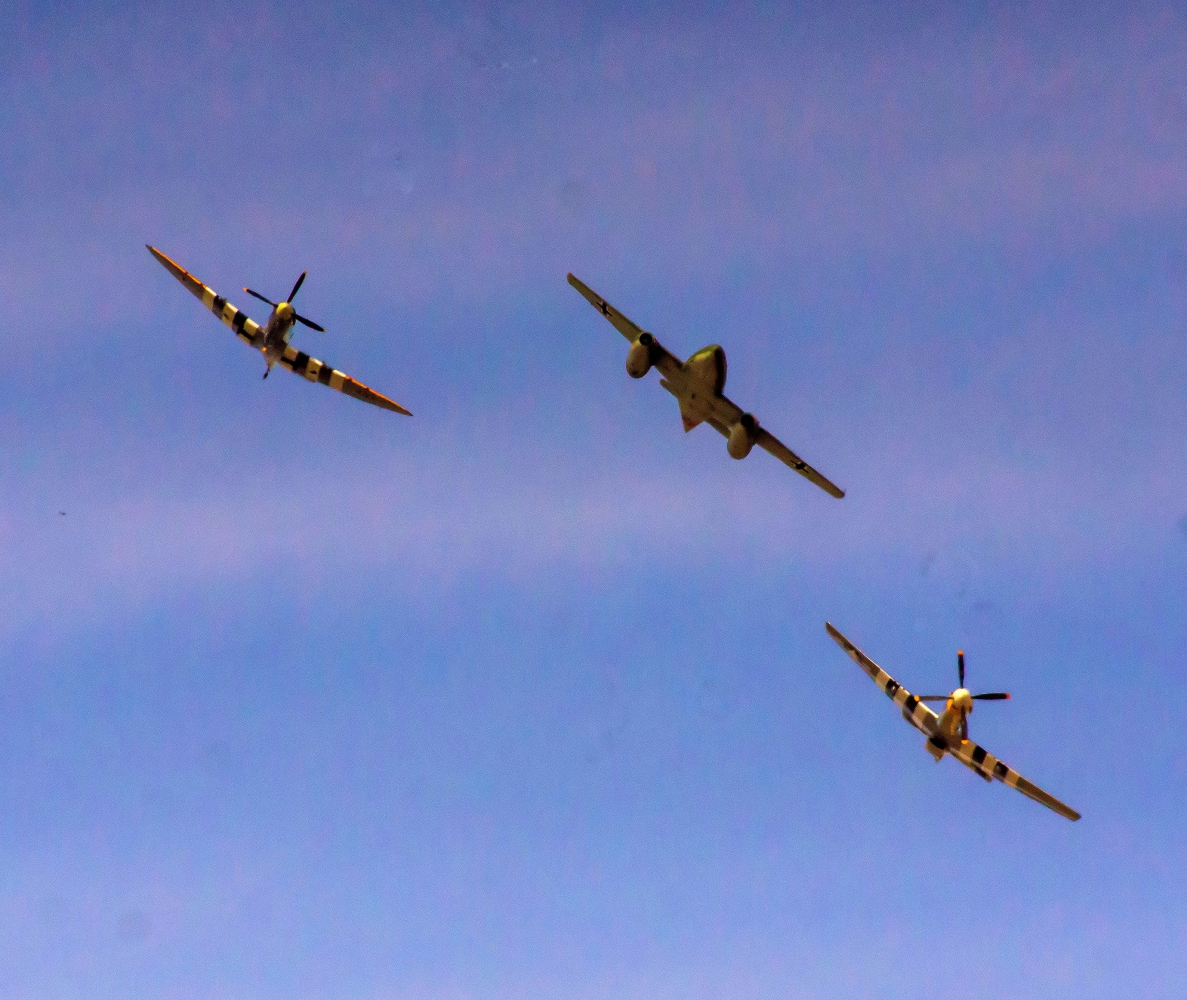
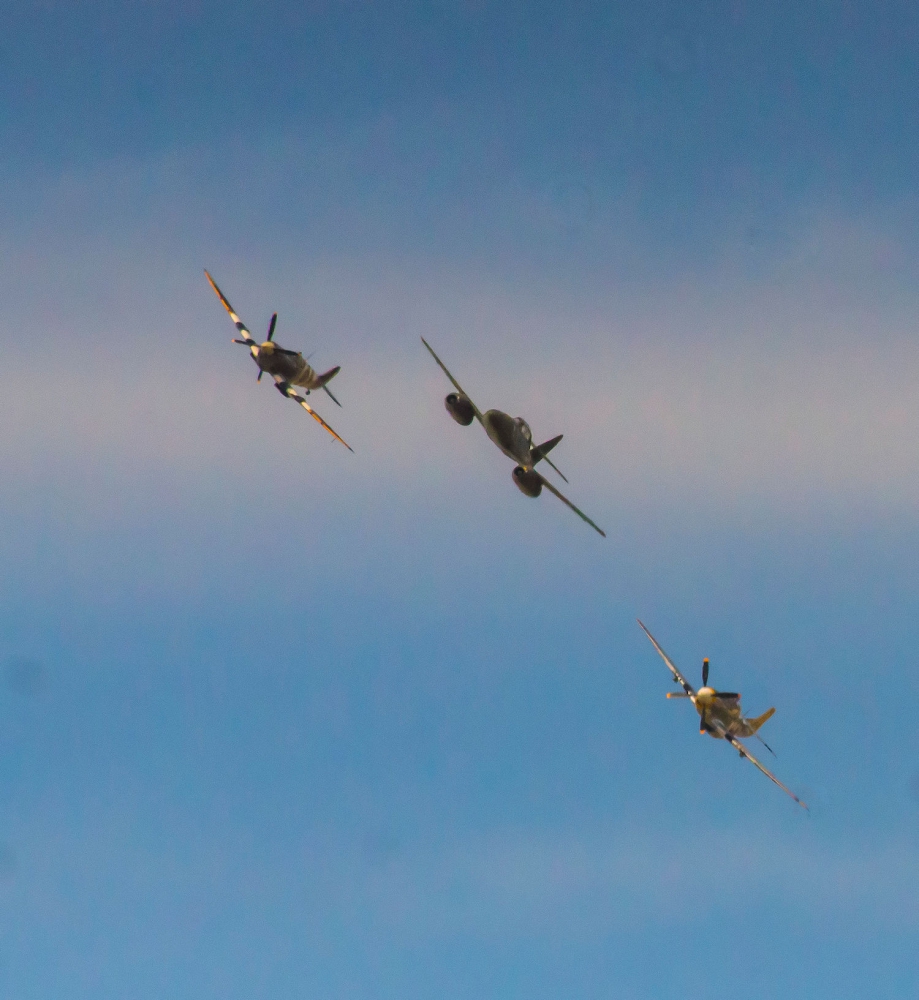
There were a couple of Curtiss P-40 Warhawks that made the show. Always crowd favorites. The P-40 was the airplane that Claire Chennault's Flying Tigers flew against the Japanese in China.
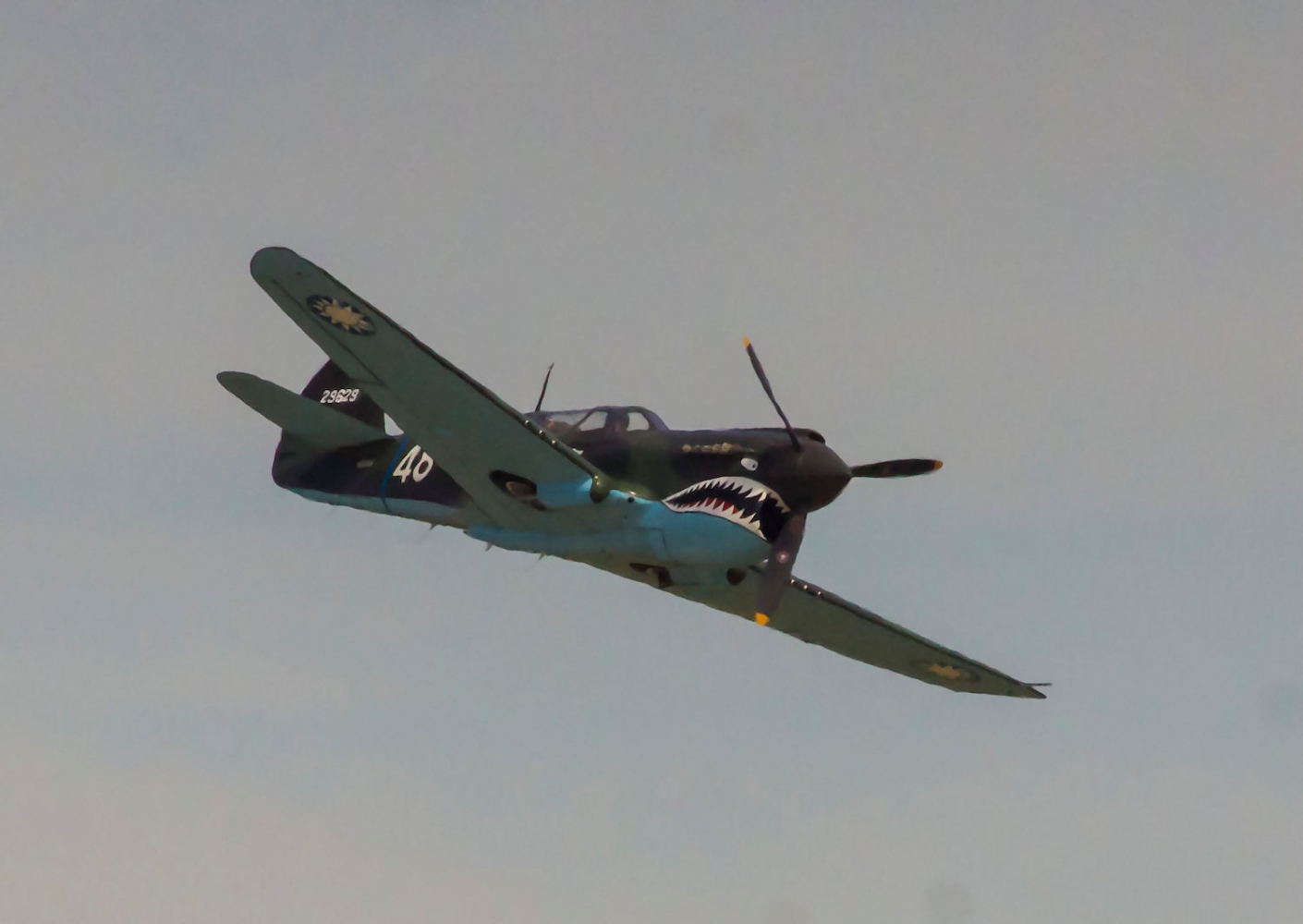
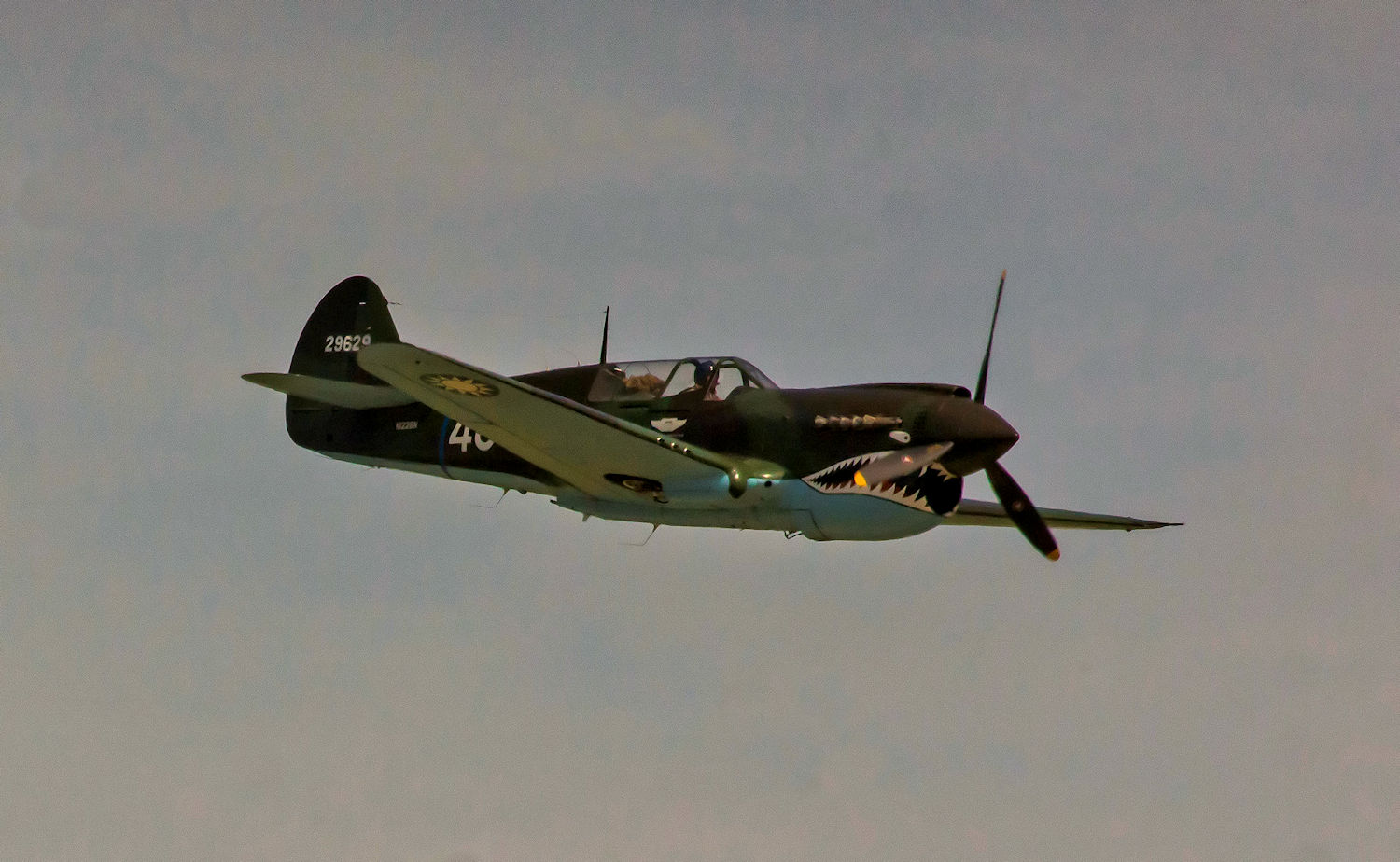

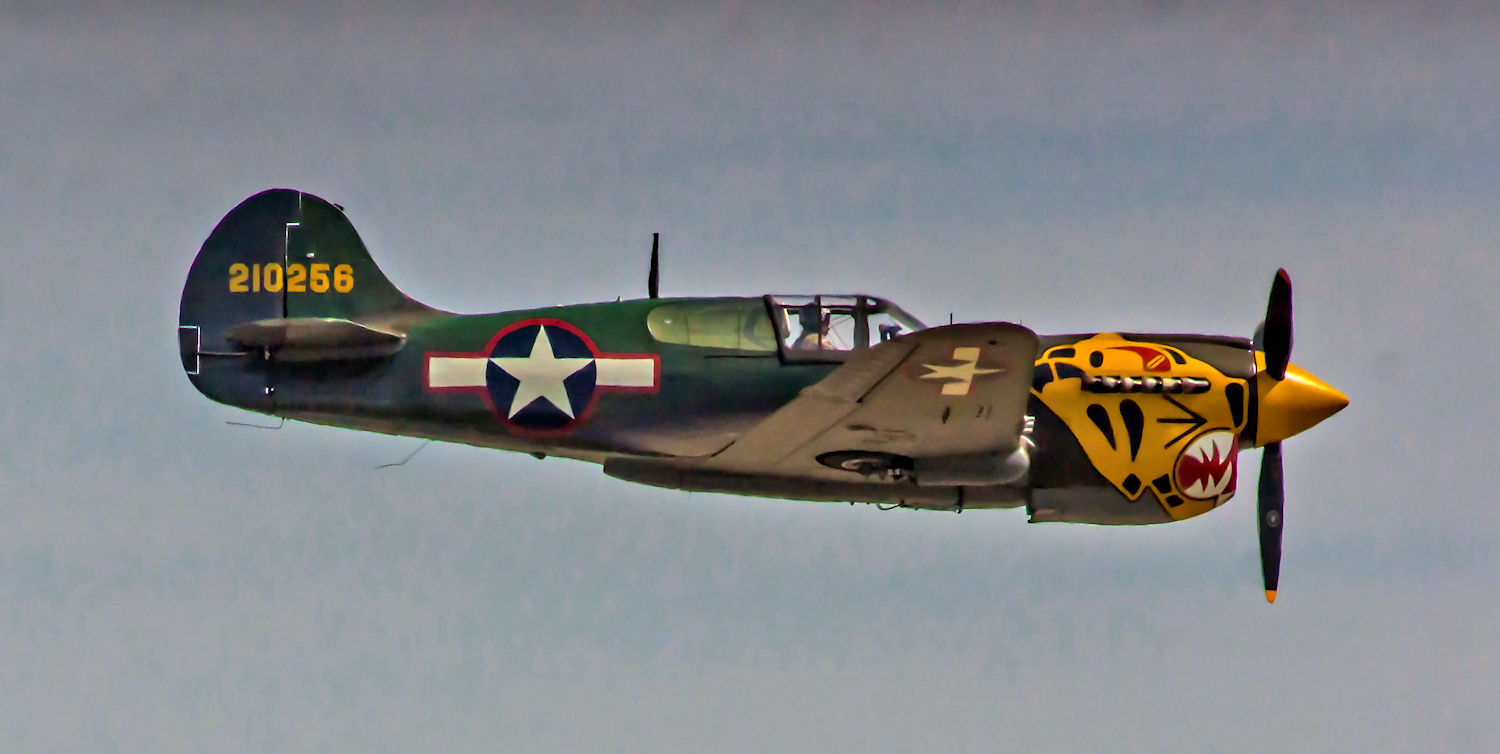

There were two B-25 Mitchells at the show, but only one flew. Nice looking plane in its desert camo paint job.
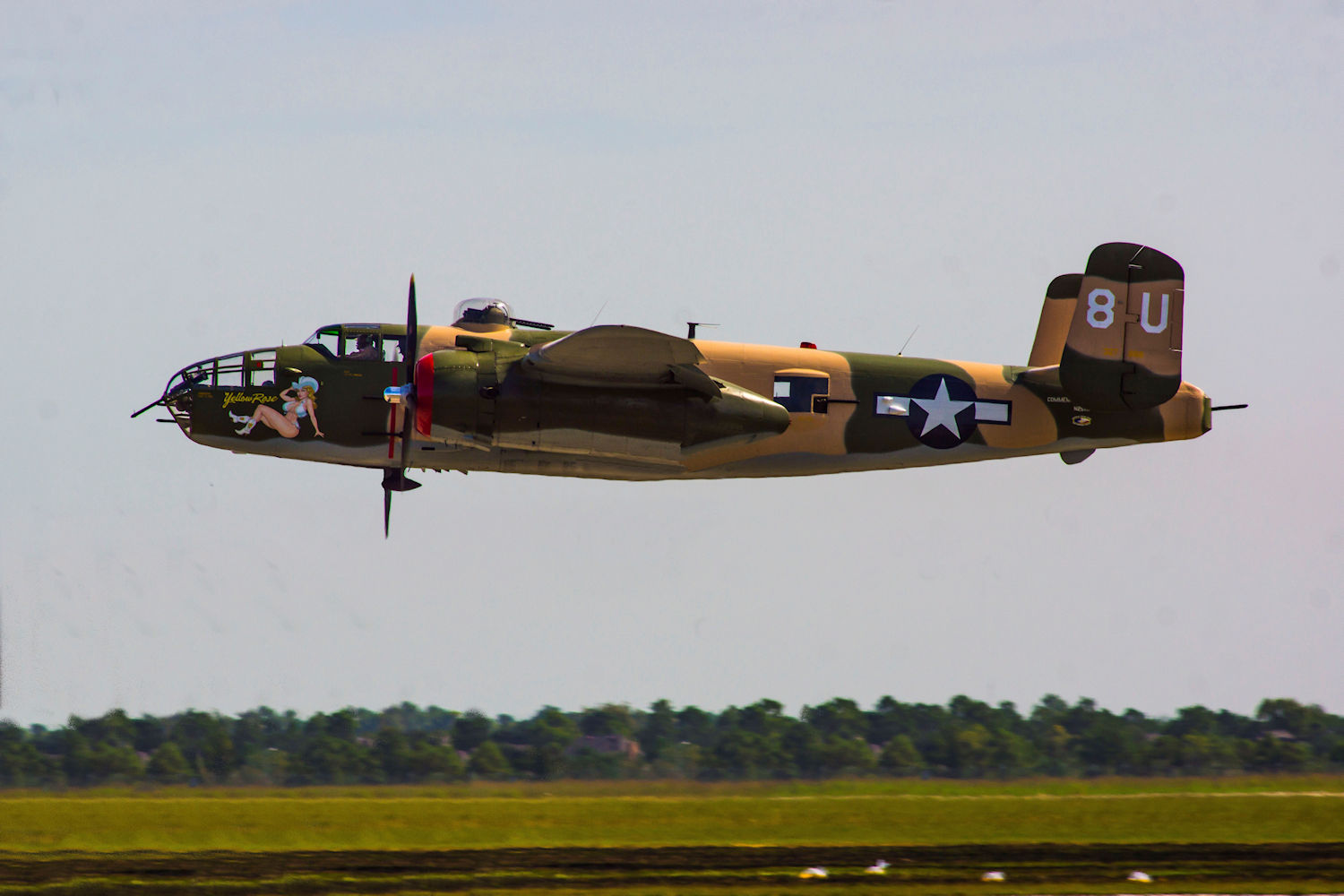
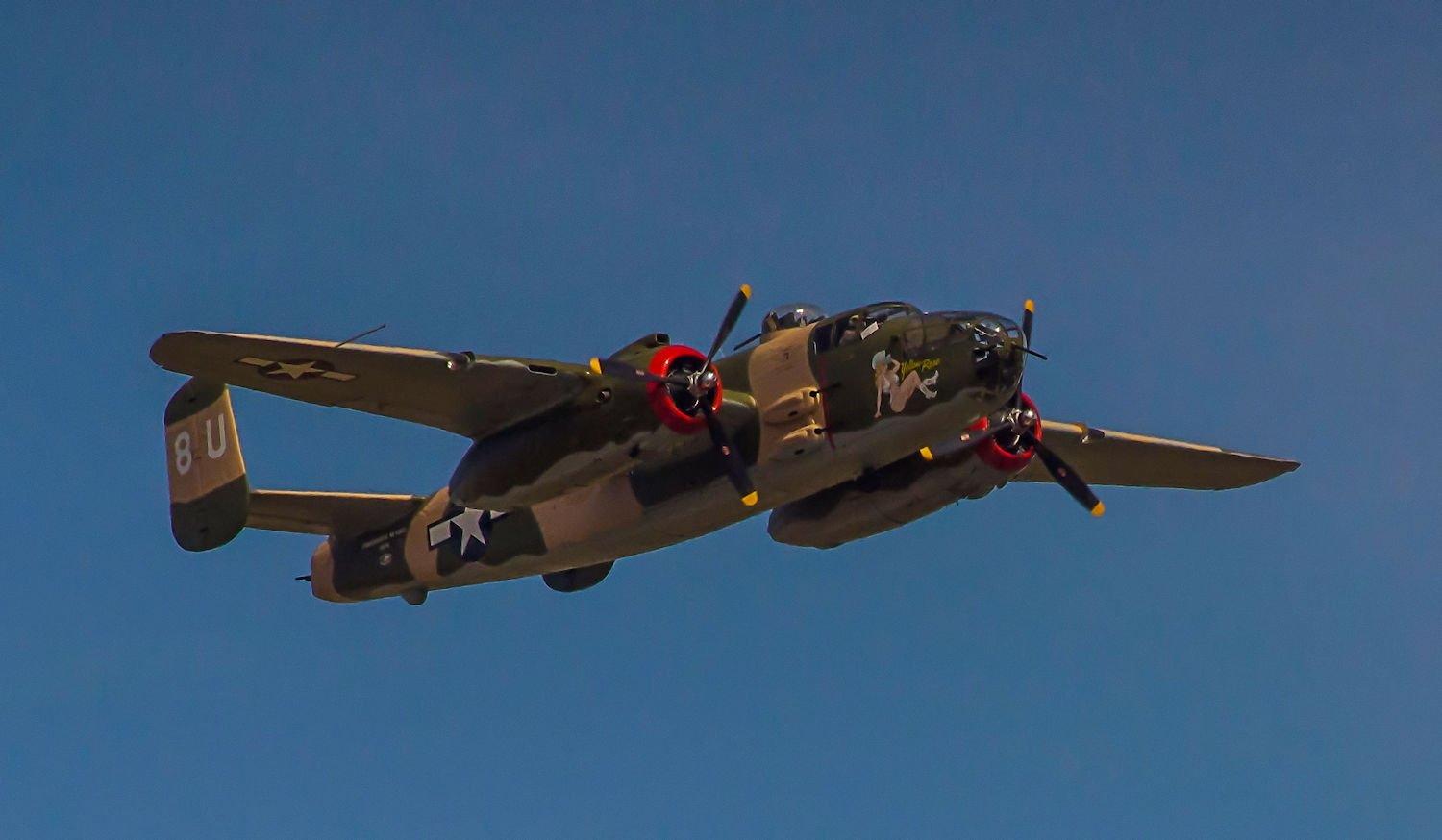
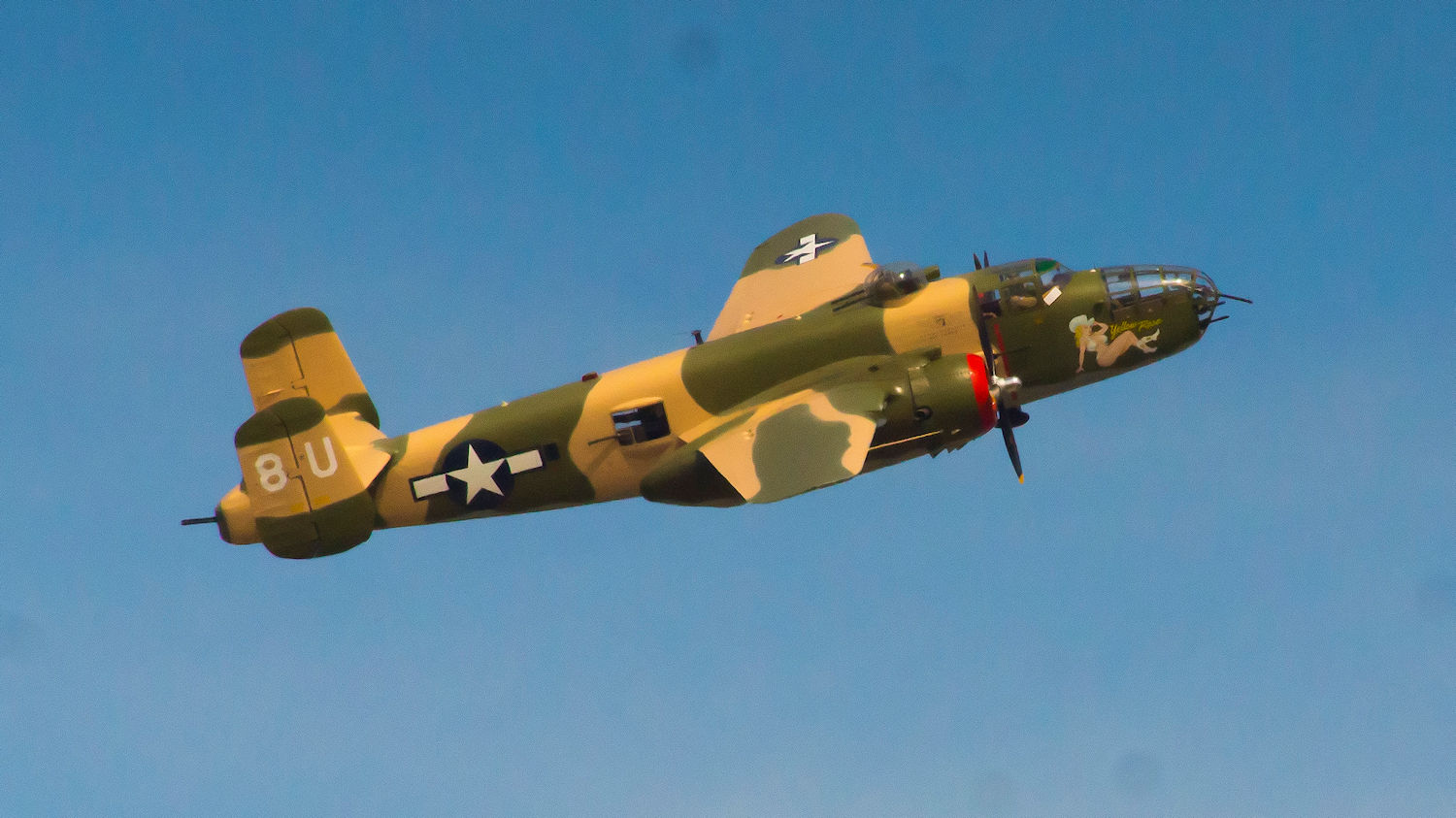
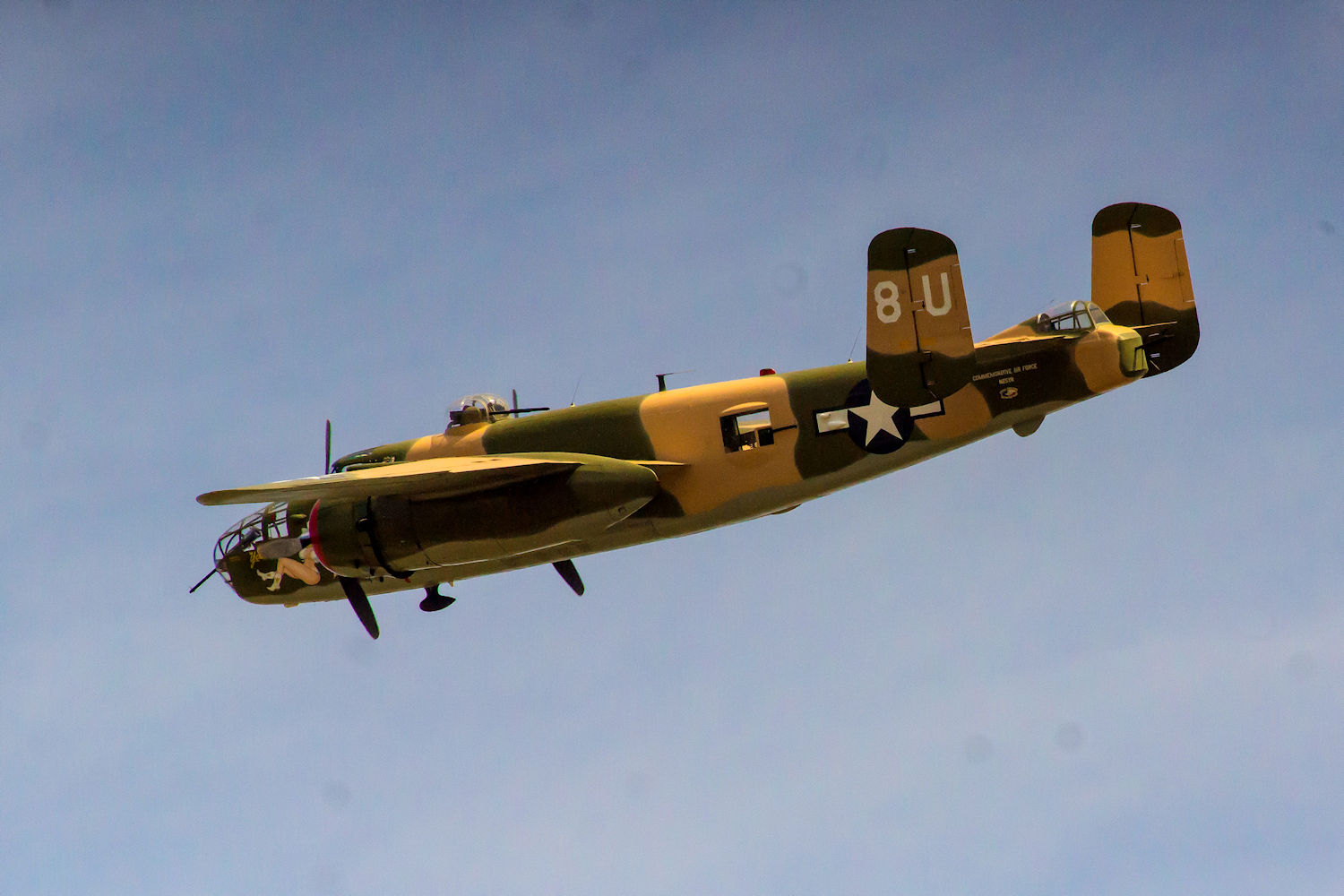
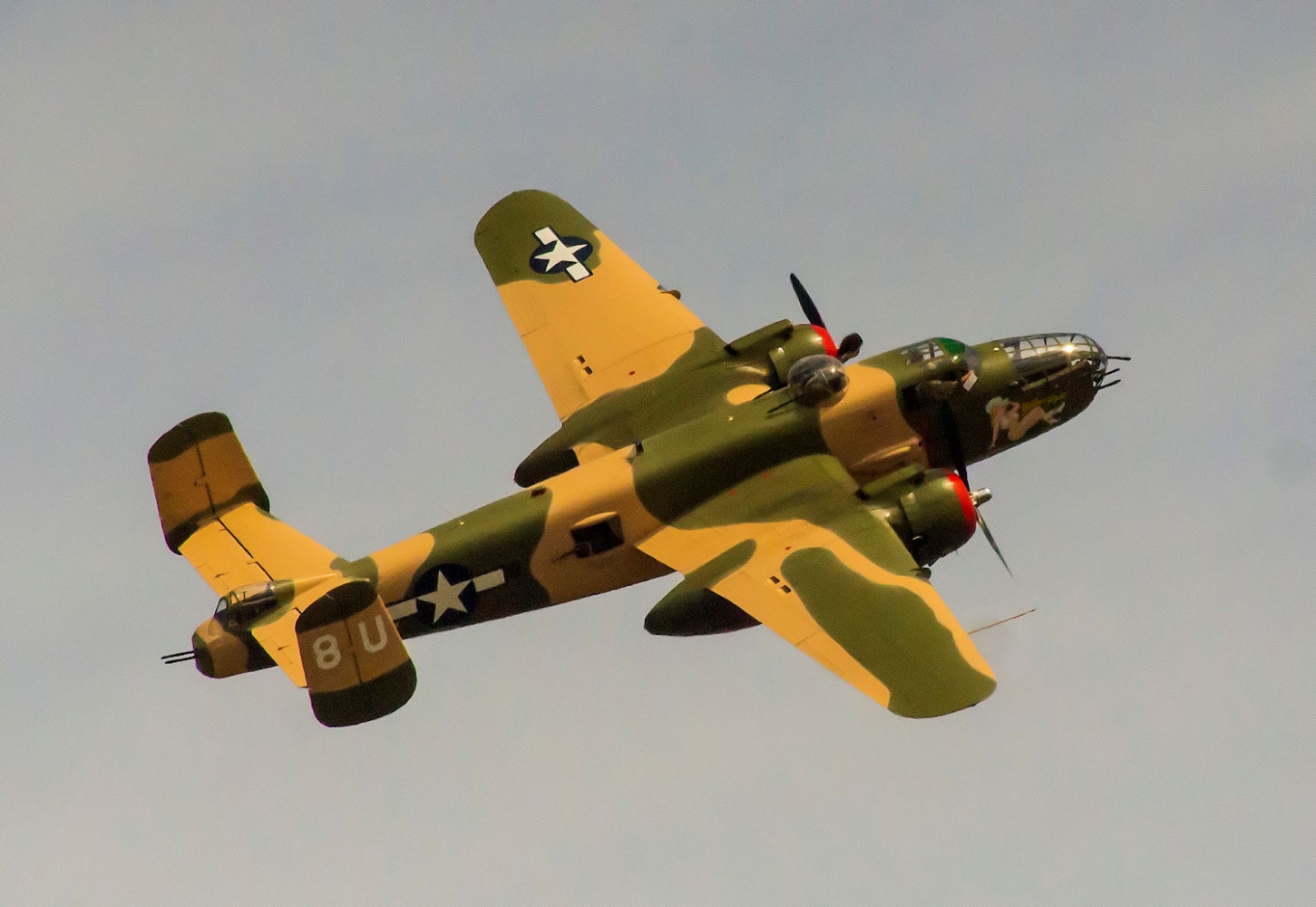
This B-17 is a regular participant at the WOH show. It is hangered down in Galveston, which is only about 30 miles from the air base, only a few minutes by air.

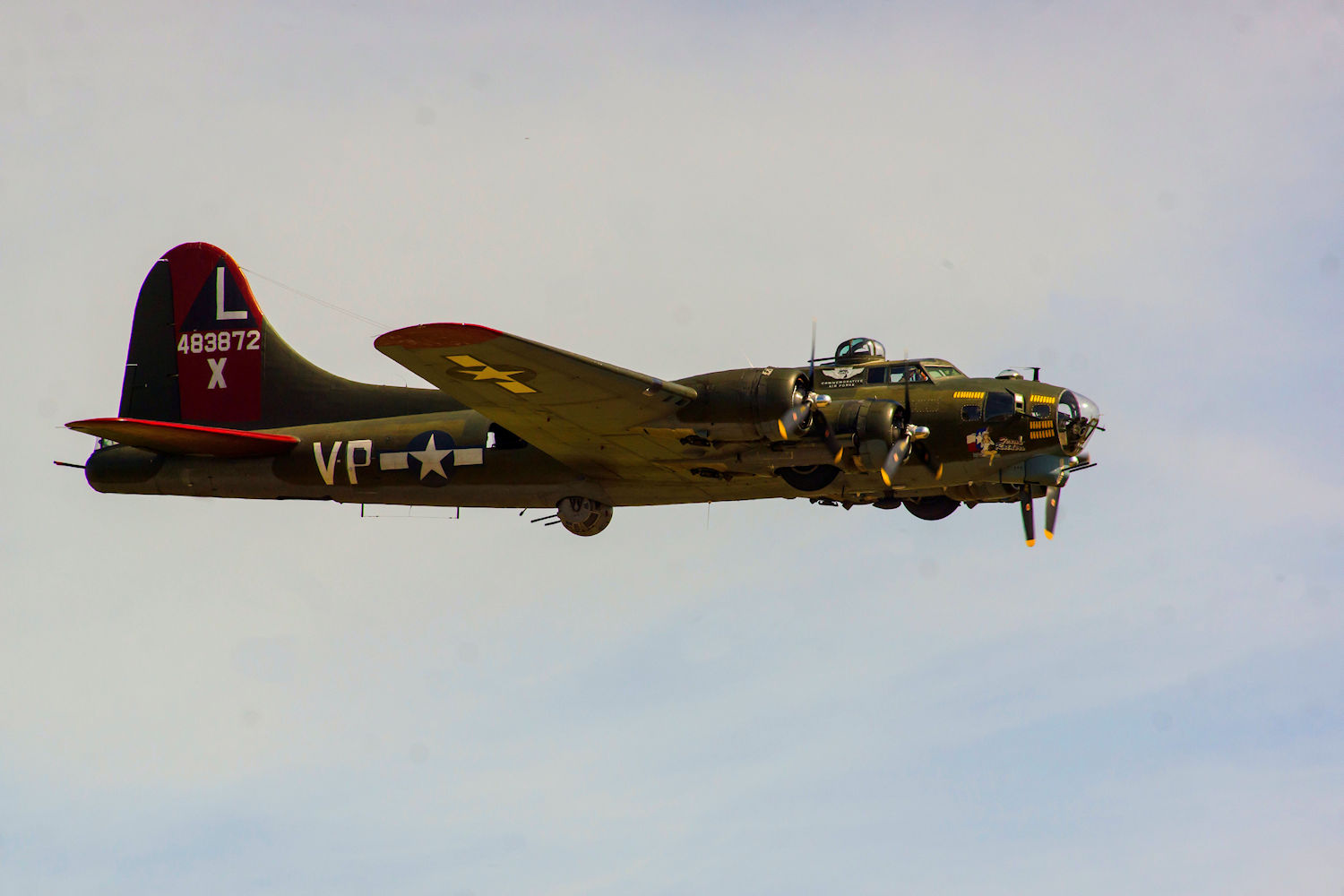
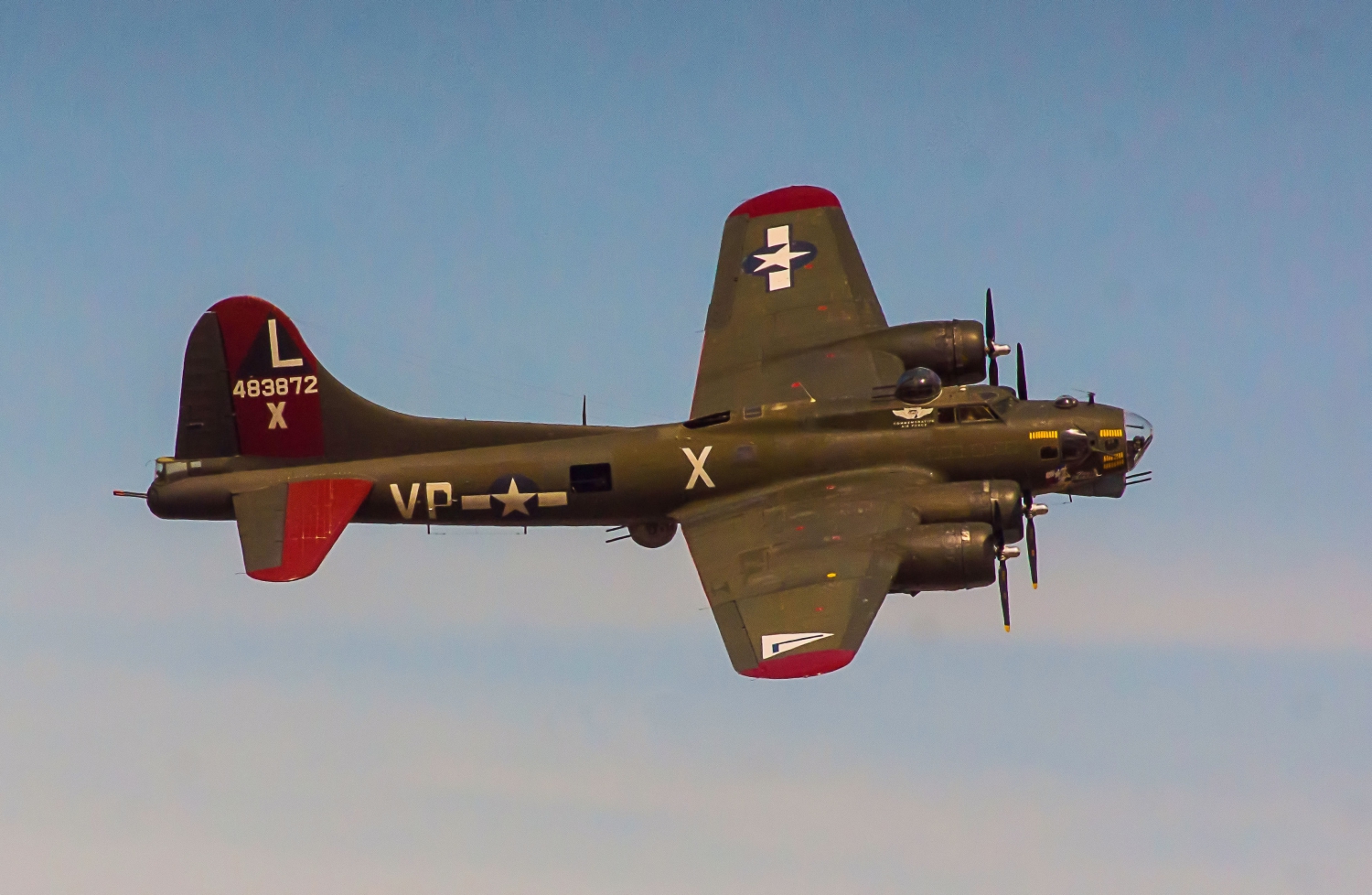
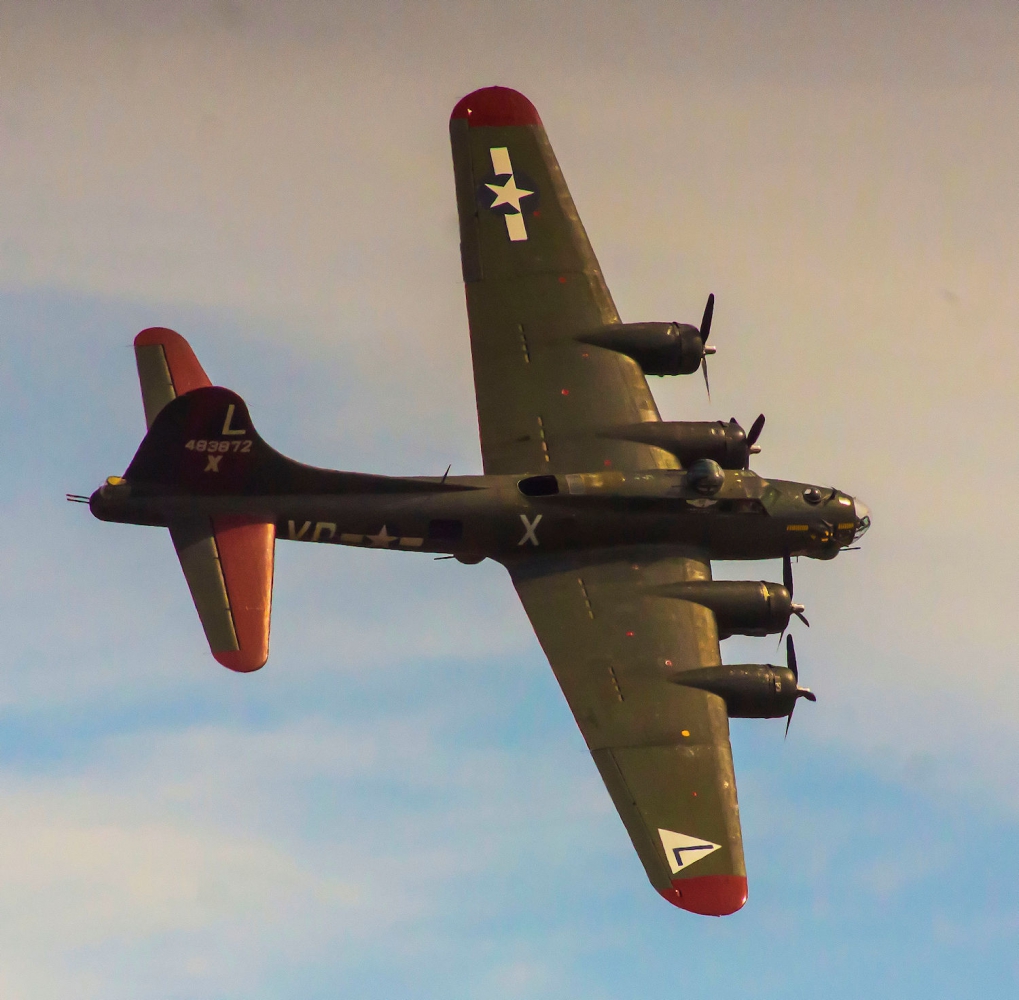
Now, a few words about how I used this Tamron 60B. I left the aperture set to f/8 or f/11, so I'd have sufficient depth of field, improving my chances of getting in-focus shots. This lens also has a small threaded knob down by the focusing collar, that, when tightened, prevents the focusing collar from being moved. For most of the show, I had it locked down at a setting almost at infinity, which was correct for most of the situations I encountered.
I hope I was successful in showing what this lens can do when working with it at infinity -- or close to it. I know most people -- me included -- would prefer to use a tripod with a lens as heavy as this one is. But I believe I've shown that it can also be used off-hand successfully, provided that one is shooting at a high enough shutter speed.
_________________
Michael
My Gear List: http://michaelmcbroom.com/photo/gear.html
My Gallery: http://michaelmcbroom.com/gallery3/index.php/
My Flickr Page: https://www.flickr.com/photos/11308754@N08/albums
My Music: https://soundcloud.com/michaelmcbroom/albums
My Blog: http://michaelmcbroom.com/blogistan/
Last edited by cooltouch on Sun Nov 01, 2015 5:24 pm; edited 4 times in total |
|
| Back to top |
|
 |
mo


Joined: 27 Aug 2009
Posts: 8979
Location: Australia
Expire: 2016-07-30
|
 Posted: Sun Nov 01, 2015 1:09 am Post subject: Posted: Sun Nov 01, 2015 1:09 am Post subject: |
 |
|
mo wrote:
You did well,very well,lovely subjects and captured beautifully. How was your arm the next day? sore?
_________________
Moira, Moderator 
Fuji XE-1,Pentax K-01,Panasonic G1,Panasonic G5,Pentax MX
Ricoh Singlex TLS,KR-5,KR-5Super,XR-10
Lenses
Auto Rikenon's 55/1.4, 1.8, 2.8... 50/1.7 Takumar 2/58 Preset Takumar 2.8/105 Auto Takumar 2.2/55, 3.5/35 Super Takumar 1.8/55...Macro Takumar F4/50... CZJ Biotar ALU M42 2/58 CZJ Tessar ALU M42 2.8/50
CZJ DDR Flektogon Zebra M42 2.8/35 CZJ Pancolar M42 2/50 CZJ Pancolar Exakta 2/50
Auto Mamiya/Sekor 1.8/55 ...Auto Mamiya/Sekor 2/50 Auto Mamiya/Sekor 2.8/50 Auto Mamiya/Sekor 200/3.5 Tamron SP500/8 Tamron SP350/5.6 Tamron SP90/2.5
Primoplan 1.9/58 Primagon 4.5/35 Telemegor 5.5/150 Angenieux 3.5/28 Angenieux 3,5/135 Y 2
Canon FL 58/1.2,Canon FL85/1.8,Canon FL 100/3.5,Canon SSC 2.8/100 ,Konica AR 100/2.8, Nikkor P 105/2.5
|
|
| Back to top |
|
 |
fuzzywuzzy


Joined: 18 Dec 2010
Posts: 1258
Location: Down East, Canada, eh?
Expire: 2013-11-30
|
 Posted: Sun Nov 01, 2015 1:20 am Post subject: Posted: Sun Nov 01, 2015 1:20 am Post subject: |
 |
|
fuzzywuzzy wrote:
Great!
_________________
I welcome C&C, editing my pics and reposting them on the forum is fine.
NEX-F3
~~~~~~~~~
CZJ Sonnar 135/4, Biotar 58/2, Pancolar 50/2, Tessar 50/2.8, Flek 35/2.8, Flek 25/4
Super Takumar 135/2.5, 135/3.5, 100/4 bellows, 50/1.4, 28/3.5
Helios 58/2, 3M-5A 500/8, Mir 20M
Vivitar Series 1 70-210 - - - - - - - - Nikkor 200/4
Rikenon 28/2.8 - - - - - - - - Zeiss 50/1.7 Planar
PB 50/2.4, 135/2.8
Yashica 50/1.9, 28/2.8, 135/2.8
Hexanon 28/3.5, 50/1.4 |
|
| Back to top |
|
 |
cooltouch


Joined: 15 Jan 2009
Posts: 9096
Location: Houston, Texas
|
 Posted: Sun Nov 01, 2015 4:54 am Post subject: Posted: Sun Nov 01, 2015 4:54 am Post subject: |
 |
|
cooltouch wrote:
| mo wrote: |
| You did well,very well,lovely subjects and captured beautifully. How was your arm the next day? sore? |
Not really, no. It isn't my arms that suffer from this air show. It's held at Ellington Air Force Base along the main flight line, where everything is about a half mile or more from everything else. So lots of walking is inevitable. I had packed all my gear in an airline-style carry-on, so I was able to wheel it along rather than having to carry it. But still . . . I have a bad back that is aggravated by walking and too much standing, so by the end of the day I'm in agony. Supporting the lens's weight tends to aggravate my back more than my arms, but my arms were also well fatigued by the end of the show. Just not sore the next day -- not like my back and legs, at any rate.
_________________
Michael
My Gear List: http://michaelmcbroom.com/photo/gear.html
My Gallery: http://michaelmcbroom.com/gallery3/index.php/
My Flickr Page: https://www.flickr.com/photos/11308754@N08/albums
My Music: https://soundcloud.com/michaelmcbroom/albums
My Blog: http://michaelmcbroom.com/blogistan/ |
|
| Back to top |
|
 |
mo


Joined: 27 Aug 2009
Posts: 8979
Location: Australia
Expire: 2016-07-30
|
 Posted: Sun Nov 01, 2015 4:59 am Post subject: Posted: Sun Nov 01, 2015 4:59 am Post subject: |
 |
|
mo wrote:
Well your suffering was worth it as these pictures testify.
_________________
Moira, Moderator 
Fuji XE-1,Pentax K-01,Panasonic G1,Panasonic G5,Pentax MX
Ricoh Singlex TLS,KR-5,KR-5Super,XR-10
Lenses
Auto Rikenon's 55/1.4, 1.8, 2.8... 50/1.7 Takumar 2/58 Preset Takumar 2.8/105 Auto Takumar 2.2/55, 3.5/35 Super Takumar 1.8/55...Macro Takumar F4/50... CZJ Biotar ALU M42 2/58 CZJ Tessar ALU M42 2.8/50
CZJ DDR Flektogon Zebra M42 2.8/35 CZJ Pancolar M42 2/50 CZJ Pancolar Exakta 2/50
Auto Mamiya/Sekor 1.8/55 ...Auto Mamiya/Sekor 2/50 Auto Mamiya/Sekor 2.8/50 Auto Mamiya/Sekor 200/3.5 Tamron SP500/8 Tamron SP350/5.6 Tamron SP90/2.5
Primoplan 1.9/58 Primagon 4.5/35 Telemegor 5.5/150 Angenieux 3.5/28 Angenieux 3,5/135 Y 2
Canon FL 58/1.2,Canon FL85/1.8,Canon FL 100/3.5,Canon SSC 2.8/100 ,Konica AR 100/2.8, Nikkor P 105/2.5
|
|
| Back to top |
|
 |
Lloydy


Joined: 02 Sep 2009
Posts: 7779
Location: Ironbridge. UK.
Expire: 2022-01-01
|
 Posted: Sun Nov 01, 2015 10:27 am Post subject: Posted: Sun Nov 01, 2015 10:27 am Post subject: |
 |
|
Lloydy wrote:
Excellent shots, having a great lens helps a lot, using it to its best is down to the photographer. I enjoyed that series of pictures.
_________________
LENSES & CAMERAS FOR SALE.....
I have loads of stuff that I have to get rid of, if you see me commenting about something I have got and you want one, ask me.
My Flickr https://www.flickr.com/photos/mudplugga/
My ipernity -
http://www.ipernity.com/home/294337 |
|
| Back to top |
|
 |
kryss


Joined: 13 Sep 2009
Posts: 2169
Location: Canada
Expire: 2017-09-18
|
 Posted: Sun Nov 01, 2015 10:58 am Post subject: Posted: Sun Nov 01, 2015 10:58 am Post subject: |
 |
|
kryss wrote:
Great shots Michael. 
_________________
Do not trust Atoms....they make up everything. |
|
| Back to top |
|
 |
DigiChromeEd


Joined: 29 Dec 2009
Posts: 3460
Location: Northern Ireland
|
 Posted: Sun Nov 01, 2015 11:26 am Post subject: Posted: Sun Nov 01, 2015 11:26 am Post subject: |
 |
|
DigiChromeEd wrote:
| kryss wrote: |
Great shots Michael.  |
+1 
_________________
"I've got a Nikon camera, I like to take a photograph" - Paul Simon |
|
| Back to top |
|
 |
tb_a


Joined: 26 Jan 2010
Posts: 3678
Location: Austria
Expire: 2019-08-28
|
 Posted: Sun Nov 01, 2015 12:09 pm Post subject: Posted: Sun Nov 01, 2015 12:09 pm Post subject: |
 |
|
tb_a wrote:

Thanks for sharing.
_________________
Thomas Bernardy
Manual focus lenses mainly from Minolta, Pentax, Voigtlaender, Leitz, Topcon and from Russia (too many to be listed here). |
|
| Back to top |
|
 |
hoanpham

Joined: 31 Jan 2011
Posts: 2575
Expire: 2015-01-18
|
 Posted: Sun Nov 01, 2015 2:30 pm Post subject: Posted: Sun Nov 01, 2015 2:30 pm Post subject: |
 |
|
hoanpham wrote:
awesome photos! |
|
| Back to top |
|
 |
marcusBMG

Joined: 07 Dec 2012
Posts: 1312
Location: Conwy N Wales
|
 Posted: Sun Nov 01, 2015 4:28 pm Post subject: Posted: Sun Nov 01, 2015 4:28 pm Post subject: |
 |
|
marcusBMG wrote:
Very good Michael.
Between my mirrorless NX20 and my pentax K5, I have no doubt that the evf when magnified (5x or 7x) is discriminating the focus more accurately than I can by eye on the K5, even with a 1.36x tenpa magnifier, specifically with those slow preset lenses I like to play with (f5.6/6.3/6.9), and mirrors. With my 60B its more of a level playing field and certainly I favour the K5 when circumstances mean I don't have time to activate the magnification on the NX20.
_________________
pentax ME super (retired)
Pentax K3-ii; pentax K-S2; Samsung NX 20; Lumix G1 + adapters;
Adaptall collection (proliferating!) inc 200-500mm 31A, 300mm f2.8, 400mm f4.
Primes: takumar 55mm; smc 28mm, 50mm; kino/komine 28mm f2's, helios 58mm, Tamron Nestar 400mm, novoflex 400mm, Vivitar 135mm close focus, 105mm macro; Jupiter 11A; CZJ 135mm.
A classic zoom or two: VS1 (komine), Kiron Zoomlock... |
|
| Back to top |
|
 |
cooltouch


Joined: 15 Jan 2009
Posts: 9096
Location: Houston, Texas
|
 Posted: Sun Nov 01, 2015 5:13 pm Post subject: Posted: Sun Nov 01, 2015 5:13 pm Post subject: |
 |
|
cooltouch wrote:
Thanks, everybody. I realize that I was pushing things including so many photos in a single post. The thing is, I have more that I left out. So I thought I'd include a few more shots in this separate post.
There were also a few more US Navy/Marines warbirds Two Grumman F8Fs made it to the show, as well as a Grumman F7F Tigercat, a rather rare Warbird that is something of a regular at the WOH show. I have some nicer pics of it from the WOH show I attended in 2013. Also, there was a single Chance-Vaught F4U Corsair that made it.
The two Grumman F8Fs:

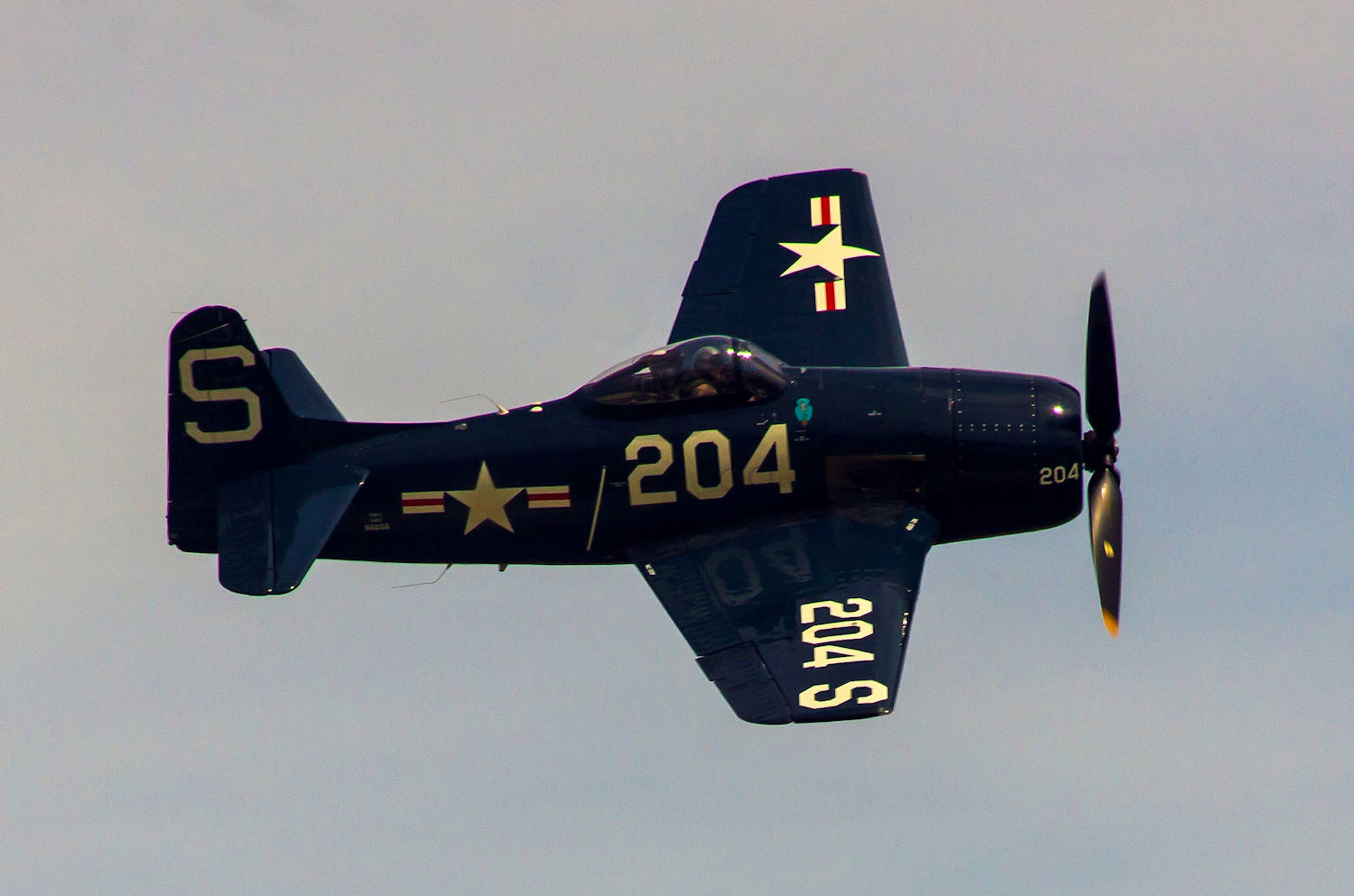
The Grumman F7F Tigercat:
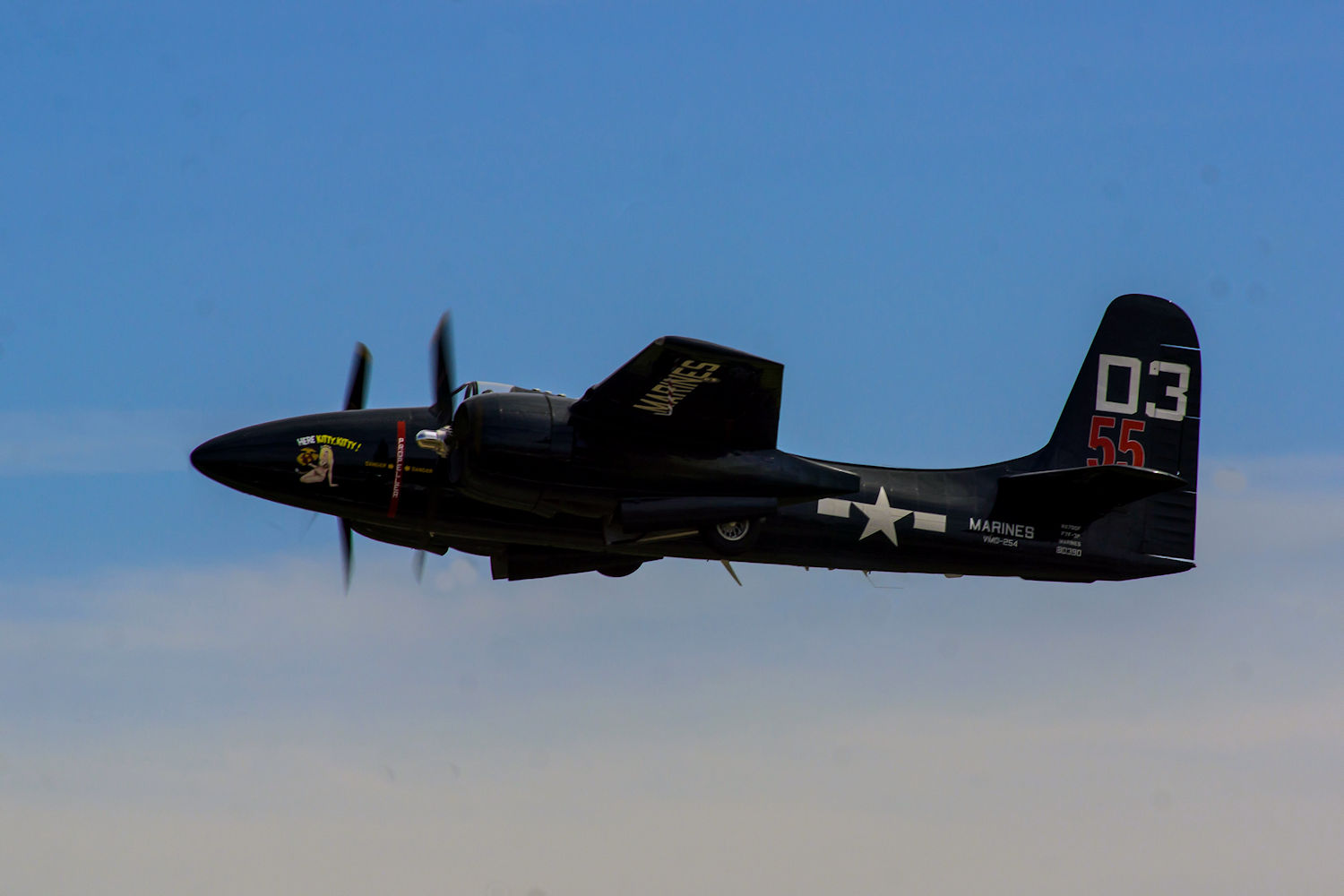

The F4U Corsair -- this is an earlier model, indicated by its 3-bladed prop. Later models had a 4-bladed prop.
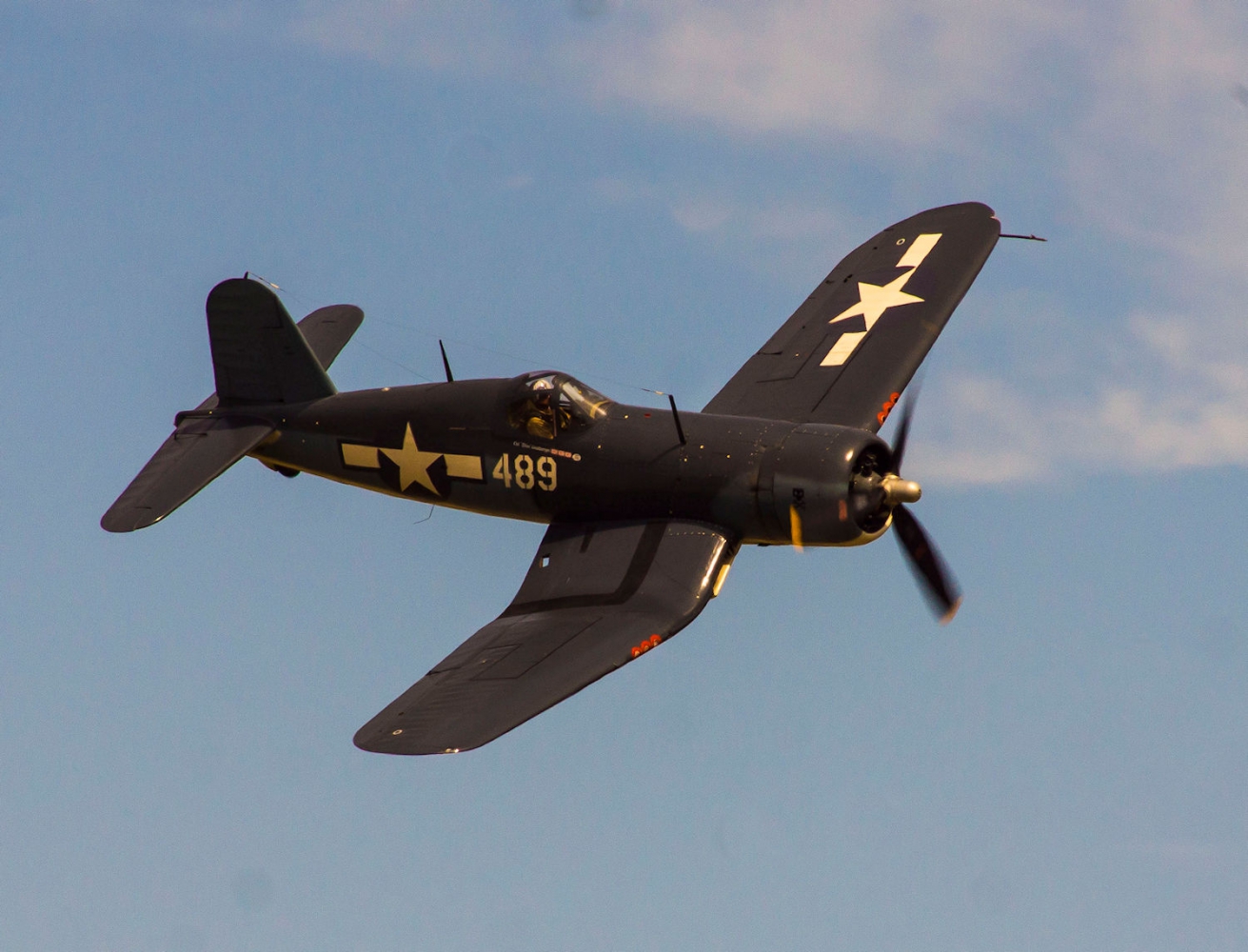
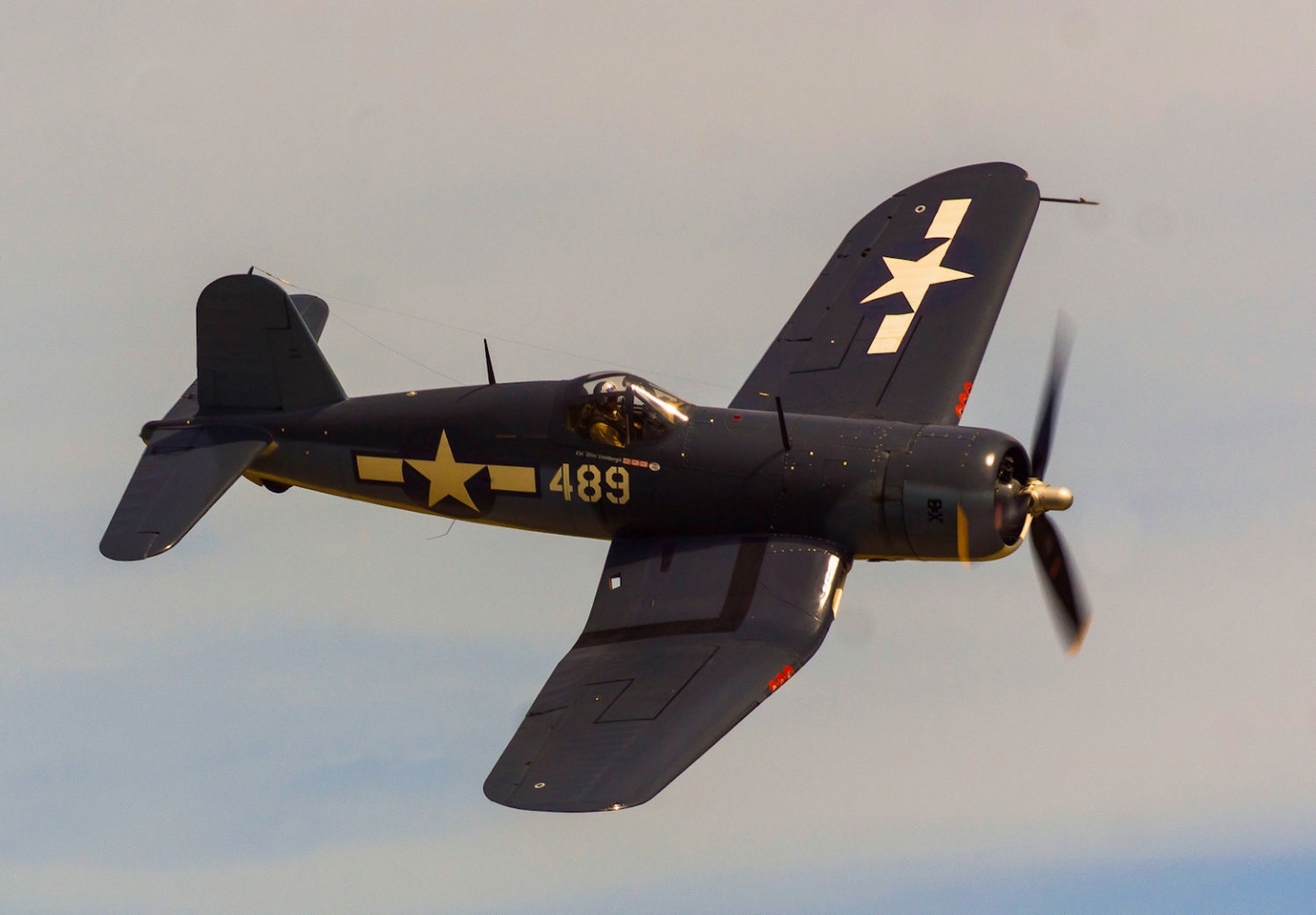
Just to illustrate this difference, here's a shot from the WOH show in 2011 where I managed to get both early and late models in a single frame. Incidentally, the early one in the below photo is the same plane as the one in the above photos.

_________________
Michael
My Gear List: http://michaelmcbroom.com/photo/gear.html
My Gallery: http://michaelmcbroom.com/gallery3/index.php/
My Flickr Page: https://www.flickr.com/photos/11308754@N08/albums
My Music: https://soundcloud.com/michaelmcbroom/albums
My Blog: http://michaelmcbroom.com/blogistan/
Last edited by cooltouch on Sun Nov 01, 2015 6:04 pm; edited 1 time in total |
|
| Back to top |
|
 |
luisalegria


Joined: 07 Mar 2008
Posts: 6602
Location: San Francisco, USA
Expire: 2018-01-18
|
 Posted: Sun Nov 01, 2015 5:17 pm Post subject: Posted: Sun Nov 01, 2015 5:17 pm Post subject: |
 |
|
luisalegria wrote:
That is a great airshow !
Better than our local San Francisco Fleet Week show, though we always have the Blue Angels.
Excellent work, and it looks like you had a really good spot.
I admire the old warbird shots, especially the SBD. That one should be the reference shot on wiki.
The fixed focus method is what I use also - just a bit under infinity, checked by test shots for approximate range. There is no way to manually focus precisely.
The 300/2.8 doesn't seem like the best lens for this job, seeing as you need to shoot at f/8 and the extra weight is a problem. Something lighter, a 5.6 ?
_________________
I like Pentax DSLR's, Exaktas, M42 bodies of all kinds, strange and cheap Japanese lenses, and am dabbling in medium format/Speed Graphic work. |
|
| Back to top |
|
 |
cooltouch


Joined: 15 Jan 2009
Posts: 9096
Location: Houston, Texas
|
 Posted: Sun Nov 01, 2015 5:56 pm Post subject: Posted: Sun Nov 01, 2015 5:56 pm Post subject: |
 |
|
cooltouch wrote:
Thanks for the perspective, Luis. I'll bet Fleet Week is a pretty good show, nonetheless -- especially with all the watercraft that must be in attendance. And if truth be known, I just like the Blue Angels better than the Thunderbirds. The BA's presentation comes across as more organized, plus I just like the looks of the BA's planes more than the T-Birds. The latter paint scheme comes across as rather gaudy and too busy for my tastes.
You present a valid point with respect to the lens. I decided to take it, though, because of its high resolution capabilities, especially at the f/5.6-f/11 sweet spot, plus it has LD glass and internal focusing (alhough I didn't focus it much, preferring to lock it down instead). I don't own any 300mm f/5.6 lenses. But I have a couple of AF zooms that are f/5.6 at the long end. I ended up using both of them -- an EF 75-300 on my EOS and a 70-300 ED on my F4.
I also own a Tokina 100-300mm f/4 SD lens in Nikon mount that is actually an outstanding performer. It's pretty big and heavy too, but nothing like the 300/2.8. I'm thinking maybe I ought to take it with me next time I come to a show like this one. And maybe I should keep my eyes peeled for a Tamron SP 300mm f/5.6 too. I've heard great things about that lens.
Marcus, honestly it didn't even occur to me to up the magnification on my NEX. I was having enough trouble keeping the aircraft in the viewfinder at regular magnification. Whenever I use increased magnification on the NEX, I almost always have it mounted to a tripod, or sometimes I'll use it to check focus if I'm shooting handheld.
Although most of the time the airplanes were lit a solid yellow in the viewfinder or on the display screen (that's the color I use for focus peaking), I still don't entirely trust focus peaking. I've proved to myself often enough that sometimes it's a bit off and I actually need to nudge the focus a bit to gett things where they need to be. In the airshow environment, however, a person just doesn't have the time to do all those things. You just have to trust it and run with it and hope to keep up.
A far bigger problem for me was keeping aircraft centered in the viewfinder because I wasn't able to rely on my other eye to track things. Still not sure why that is. Another problem I had with using the NEX 7's viewfinder is it is noticeably dimmer than optical finders in bright sun conditions. Whenever I'd take a break from the NEX and bring the F4 up to my eye, I could almost hear my eye heaving a sigh of relief because everything was brighter and so much easier to follow. Sadly, though, the F4, with its primitive AF tech, didn't want to track the aircraft, so I had to set the lens to manual and rely on the little green dot, which wasn't much of a help, really, and just my old Mark 1 eyeball to make sure shots with the F4 were in focus. No wonder pros started switching over to Canon during the early 90s.
I have an Nikon N80 35mm SLR also and I debated back and forth whether I should take the F4 with its primitive AF but much faster motor drive or the N80 with its much more advanced AF tech but "only" 3.5 fps motor drive. I think I should have taken the N80, truth be told. The little Canon XS plugged along just as it always has, handling AF issues easily and rendering almost all of its photos in focus.
_________________
Michael
My Gear List: http://michaelmcbroom.com/photo/gear.html
My Gallery: http://michaelmcbroom.com/gallery3/index.php/
My Flickr Page: https://www.flickr.com/photos/11308754@N08/albums
My Music: https://soundcloud.com/michaelmcbroom/albums
My Blog: http://michaelmcbroom.com/blogistan/ |
|
| Back to top |
|
 |
Lloydy


Joined: 02 Sep 2009
Posts: 7779
Location: Ironbridge. UK.
Expire: 2022-01-01
|
 Posted: Sun Nov 01, 2015 8:29 pm Post subject: Posted: Sun Nov 01, 2015 8:29 pm Post subject: |
 |
|
Lloydy wrote:
Michael, I gotta ask - what was your hit rate % ? These images are very good. Years ago I lived on the edge of a RAF base that has one of the UK's best airshows, I could get in direct line of the runway about 300 meters away. I tried year after year with a Canon A1 and various lenses up to 300mm with poor results, and good shots were pure luck. Obviously a modern digital camera gives a great advantage, for a start you're not using film at 5 fps with a motor drive ! Air shows are difficult, they require skill to get decent images. I have many negatives of sky.
_________________
LENSES & CAMERAS FOR SALE.....
I have loads of stuff that I have to get rid of, if you see me commenting about something I have got and you want one, ask me.
My Flickr https://www.flickr.com/photos/mudplugga/
My ipernity -
http://www.ipernity.com/home/294337 |
|
| Back to top |
|
 |
cooltouch


Joined: 15 Jan 2009
Posts: 9096
Location: Houston, Texas
|
 Posted: Mon Nov 02, 2015 12:18 am Post subject: Posted: Mon Nov 02, 2015 12:18 am Post subject: |
 |
|
cooltouch wrote:
Hey Lloyd,
Well, since you asked . . . at this last airshow I shot about 500 images with the Tamron/NEX. Of these 500, about 150 were keepers, but of those 150, I consider focus to be just acceptable with about 20 or so. So if I want to get picky about it, my percentage rate is more like 130/500, or about 26%. Not particularly good, really. When I attended my first airshow with my new Canon DSLR back in 2009, I shot about 800 photos and almost all were keepers. I never had that sort of luck when I was shooting 35mm back in my old slide-shooting days. Typically my percentage would be better than 26% back then, but rarely did it approach 50%. There's just too much that can go wrong when shooting with a mechanical, manual-exposure camera with manual focus lenses.
I also was using a Canon A-1 during the first few airshows I attended and I had the Motor Drive MA for it, so yeah, I could burn through a roll of 36 exp. film in a hurry if I wanted. I cured myself of that real fast, though. On my first outing with my new MD-MA, I took my rig with me out to a local go-cart track and blazed away. Within seconds I'd burned through a 36-exp roll of film and at that point it dawned on me that I might want to be a bit more selective and avoid the spray and pray attitude. Sure enough, when I got the slides back from that outing, I had maybe one or two keepers out of that 36-exposure roll. From that point on, I still used the MD-MA with my A-1, but only so I didn't have to take my eye away from the viewfinder if I needed to fire off a follow-up shot.
I put that A-1 out to pasture maybe a year later. I bought an FTb, then an old F-1, then another old F-1, and by that time I was pretty well committed to manual exposure FD cameras. I also bought the big motor drives for both F-1s for the same reason -- so I could keep my eye at the viewfinder for possible follow-up shots. By that time, for long lenses I had a Canon 300mm f/4 and a Tamron SP 60-300mm f/3.8-5.4. The Canon 300 was a bit tricky to use because it would exhibit a lot of chromatic aberration under certain situations, so I mostly carried the Tamron zoom. I also had a Sigma 600mm mirror I'd take and use on occasion. The Canons were the bulk of what I used during my slide-shooting days and almost all the airshows I attended back in the 1980s. In 1989 I transitioned over to Nikon for a while and attended a few airshows with an F2 and F3, plus a copy of the Tamron 300/2.8 that I used to own and a 180/2.8 ED Nikkor.
I was using better glass with the Nikons and it made a difference, but without the technique it wouldn't have mattered what I used. And as for technique, the number one tip I can pass along is to pan with the aircraft all the way through. Number two tip is to prefocus so you're not having to worry about that while you're following the plane.
_________________
Michael
My Gear List: http://michaelmcbroom.com/photo/gear.html
My Gallery: http://michaelmcbroom.com/gallery3/index.php/
My Flickr Page: https://www.flickr.com/photos/11308754@N08/albums
My Music: https://soundcloud.com/michaelmcbroom/albums
My Blog: http://michaelmcbroom.com/blogistan/ |
|
| Back to top |
|
 |
Lloydy


Joined: 02 Sep 2009
Posts: 7779
Location: Ironbridge. UK.
Expire: 2022-01-01
|
 Posted: Mon Nov 02, 2015 12:59 am Post subject: Posted: Mon Nov 02, 2015 12:59 am Post subject: |
 |
|
Lloydy wrote:
That's an impressive hit rate, I'd be happy with that anytime. I had more success with the Canon A1 than I did with the Canon EOS 600 ( 630 in the USA ) with a 100-300 USM lens, I don't think I ever got a decent picture of a plane with that, wasted plenty of film though. Isn't digital wonderful. 
_________________
LENSES & CAMERAS FOR SALE.....
I have loads of stuff that I have to get rid of, if you see me commenting about something I have got and you want one, ask me.
My Flickr https://www.flickr.com/photos/mudplugga/
My ipernity -
http://www.ipernity.com/home/294337 |
|
| Back to top |
|
 |
spiralcity


Joined: 02 Oct 2008
Posts: 1207
Location: Chicago, U.S.A
|
 Posted: Mon Nov 02, 2015 10:08 pm Post subject: Posted: Mon Nov 02, 2015 10:08 pm Post subject: |
 |
|
spiralcity wrote:
I'm a huge fab of WWII aviation. thanks for sharing the great shots.
_________________
Nikons : F4-EM-FG-FE2-FA-EL-FTN-N2020-N70-F Nikkorex
Fujica: ST605N-ST701-ST705-ST705W-ST801-ST901-AZ1-AX-3
Chinon: CE4s-CM4s-CM5
Pentax: ME-Soptmatic
Ricoh:XR6
Pentax- K10D
Lenses- M42's-Nikon F mount, Pentax PK
FREE PHOTOGRAPHY COURSE |
|
| Back to top |
|
 |
cooltouch


Joined: 15 Jan 2009
Posts: 9096
Location: Houston, Texas
|
 Posted: Tue Nov 03, 2015 5:44 am Post subject: Posted: Tue Nov 03, 2015 5:44 am Post subject: |
 |
|
cooltouch wrote:
I'm glad you liked it. I'm a big fan of the old warbirds myself, especially WWII aircraft of all sorts. I have a collection of photos that include air shows from years ago as well as some of the most recent air shows here in Houston. There's a good assortment of warbirds pics in the collection. Unfortunately, the pics aren't organized by era or type of aircraft. So you pretty much get to sort through the collection -- about 14 pages worth. You can find it here:
http://michaelmcbroom.com/gallery3/index.php/Aircraft
_________________
Michael
My Gear List: http://michaelmcbroom.com/photo/gear.html
My Gallery: http://michaelmcbroom.com/gallery3/index.php/
My Flickr Page: https://www.flickr.com/photos/11308754@N08/albums
My Music: https://soundcloud.com/michaelmcbroom/albums
My Blog: http://michaelmcbroom.com/blogistan/ |
|
| Back to top |
|
 |
|
|
